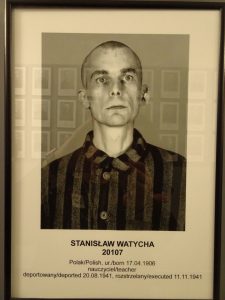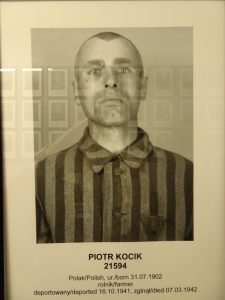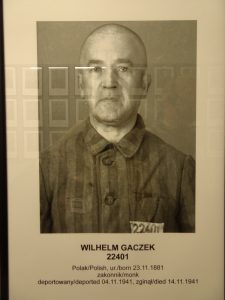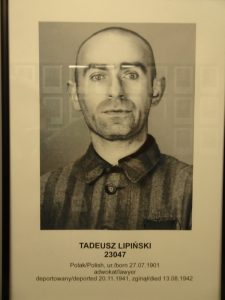The rattling of trams woke us up this morning from, for my part, the worst night sleep I have had in a long time. Not even the Valium helped. I think the bed was broken – it had no support under it and it was sloping to the side somewhat, every time I rolled over, (which was often because I felt like I was constantly going to fall out of bed) something creaked and clunked under the bed frame. So yay, welcome to another busy day and this time with about four hours sleep. 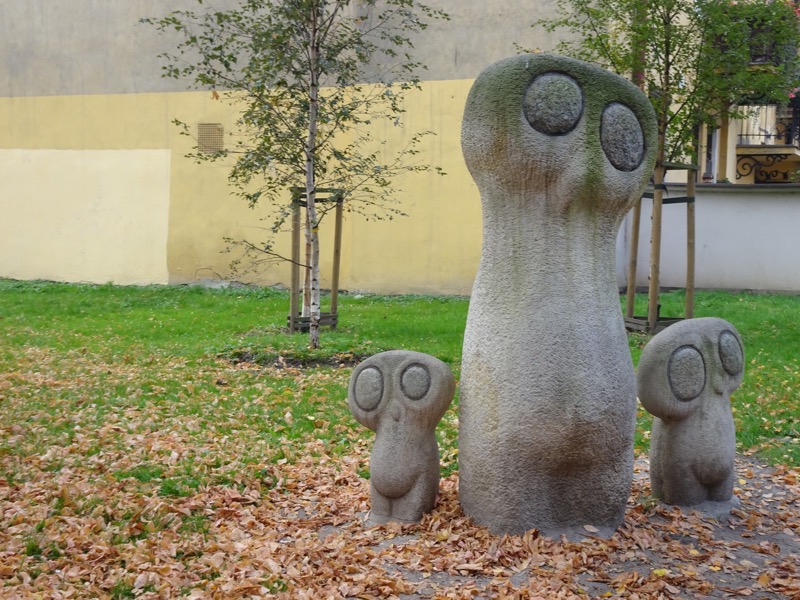 Walking up to Wawel Castle…
Walking up to Wawel Castle…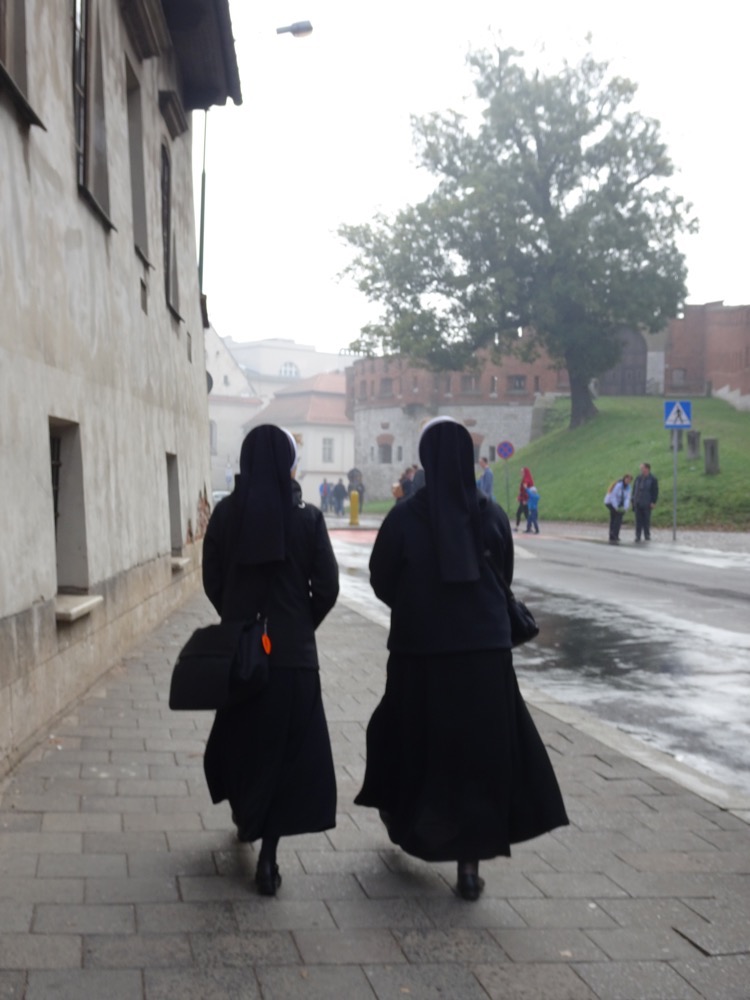 We were planning on visiting the historic district of Wawel Castle just for the morning. It is located pretty much in the centre of Kraków and was built by King Kazimierz III, also known as Casimir III the Great, in the 13th and 14th centuries. The castle is actually a large complex made up of a number of Medieval/Renaissance/ Baroque buildings around a very large Italian style courtyard making it one of the largest in Poland. Most of the Wawel Royal Castle and the Wawel Hill area are considered the most culturally/historically significant areas in the entire country. Sometimes I feel like I am travelling the world ticking off UNESCO World Heritage Sites, as this is another one of them
We were planning on visiting the historic district of Wawel Castle just for the morning. It is located pretty much in the centre of Kraków and was built by King Kazimierz III, also known as Casimir III the Great, in the 13th and 14th centuries. The castle is actually a large complex made up of a number of Medieval/Renaissance/ Baroque buildings around a very large Italian style courtyard making it one of the largest in Poland. Most of the Wawel Royal Castle and the Wawel Hill area are considered the most culturally/historically significant areas in the entire country. Sometimes I feel like I am travelling the world ticking off UNESCO World Heritage Sites, as this is another one of them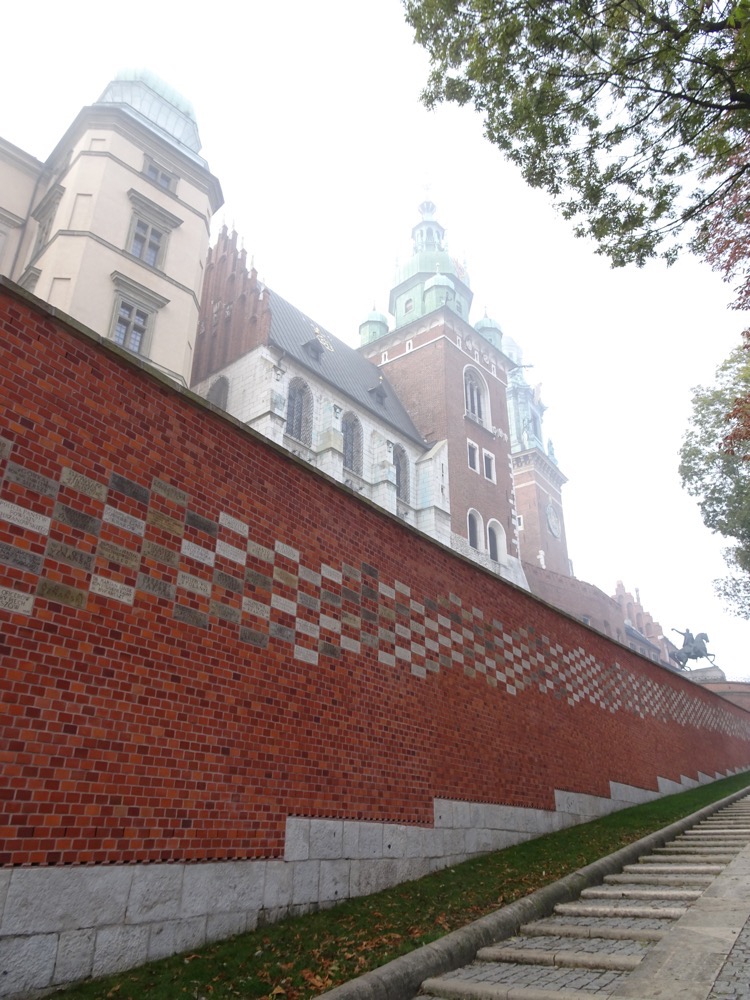
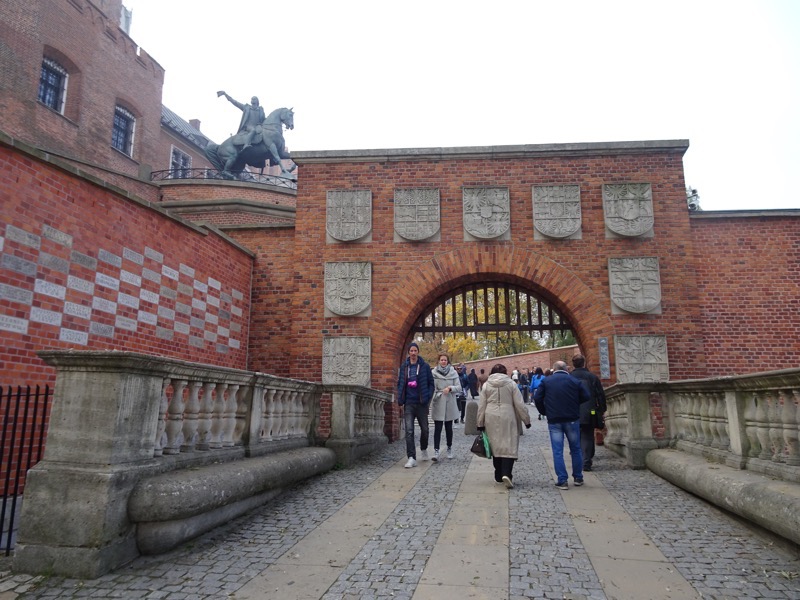 Buying tickets proved quite the experience. There was a (thankfully, short) queue of about 20 people waiting to buy tickets to enter the caste. We couldn’t figure out why the line was moving so slowly. Turns out you don’t just buy a ticket to the Castle and wander on it following a structured flow through the museum, but rather you choose which sections of the castle you wish to see and then are told when you can go see them.
Buying tickets proved quite the experience. There was a (thankfully, short) queue of about 20 people waiting to buy tickets to enter the caste. We couldn’t figure out why the line was moving so slowly. Turns out you don’t just buy a ticket to the Castle and wander on it following a structured flow through the museum, but rather you choose which sections of the castle you wish to see and then are told when you can go see them.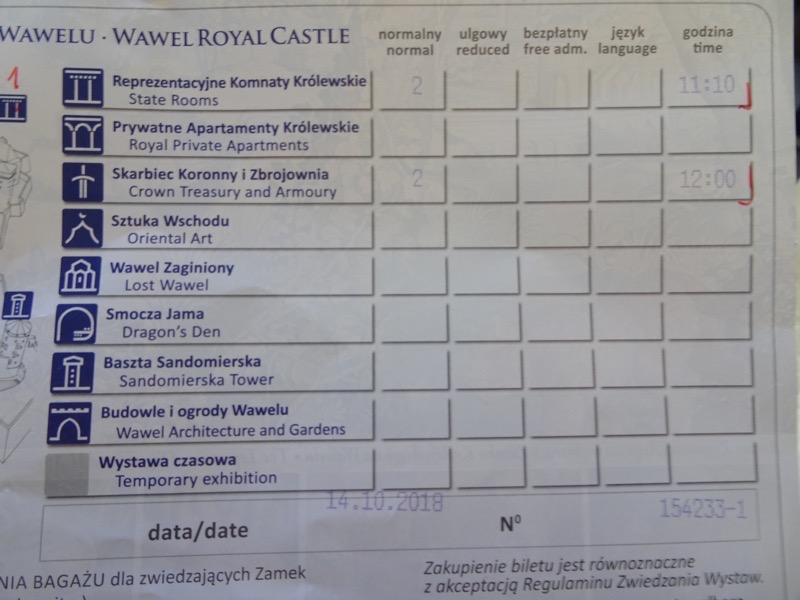 So we arrive around 10:00, go wait in line for a rather complex ticketing system and find ourselves unable to enter anywhere for another 20 minutes. :/ I understand the concept is probably about crowd control during the busiest of summer periods but none of this information is easily available online (it is once you know to look for it), and you can’t buy tickets in advance, and of course, there is only one person serving all the somewhat confused visitors. We were told if we wanted to visit the Royal Apartments we wouldn’t get an entry time until 14:00, and once inside we saw plenty of people loitering around the courtyard waiting for their appointed times to go in.
So we arrive around 10:00, go wait in line for a rather complex ticketing system and find ourselves unable to enter anywhere for another 20 minutes. :/ I understand the concept is probably about crowd control during the busiest of summer periods but none of this information is easily available online (it is once you know to look for it), and you can’t buy tickets in advance, and of course, there is only one person serving all the somewhat confused visitors. We were told if we wanted to visit the Royal Apartments we wouldn’t get an entry time until 14:00, and once inside we saw plenty of people loitering around the courtyard waiting for their appointed times to go in.
The city was very foggy when we left the hotel this morning, but it was going to be a lovely day. Side entrance to the cathedral part of the complex.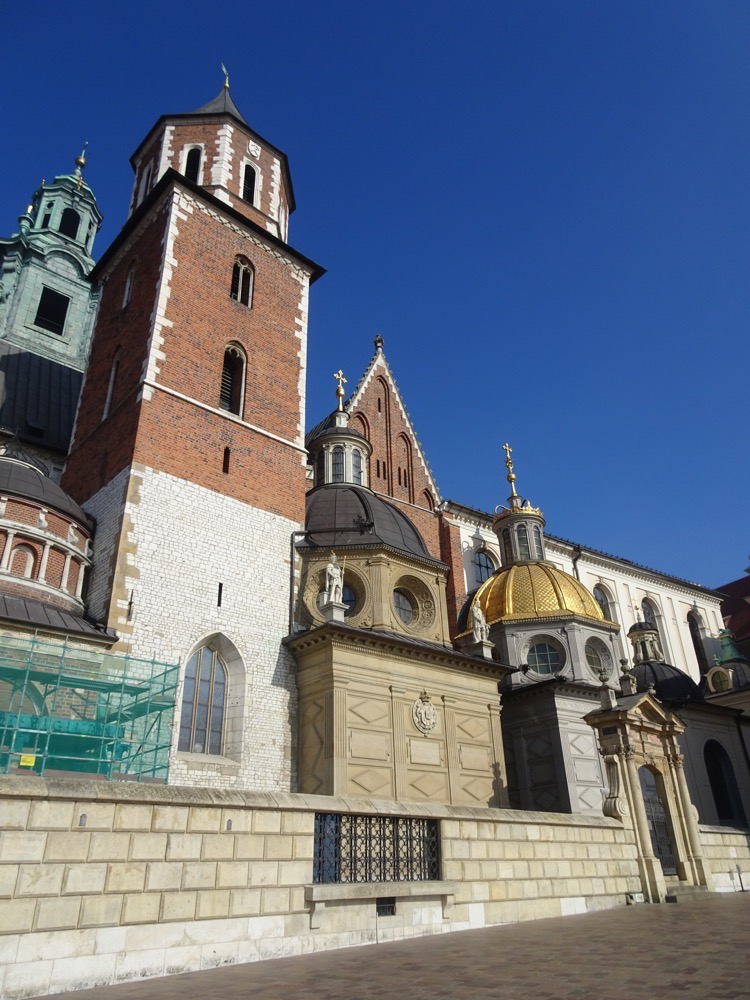 Forecourt:
Forecourt: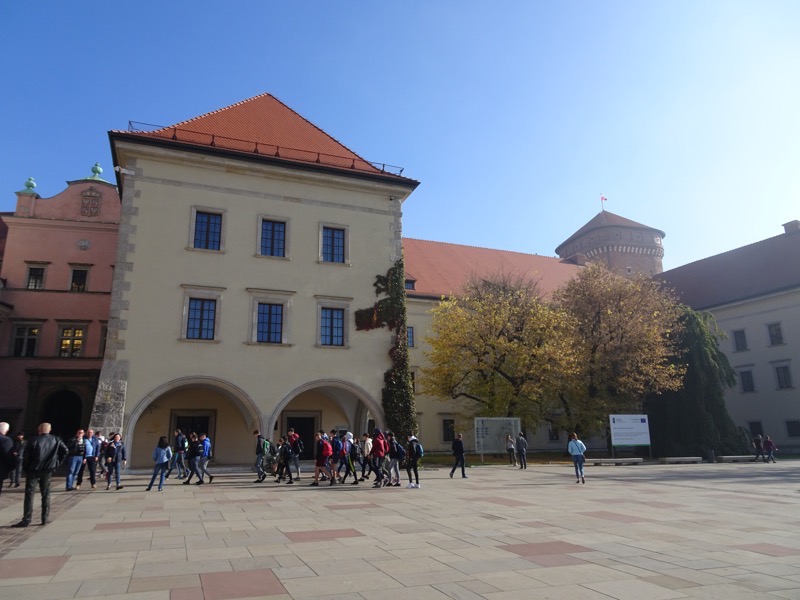
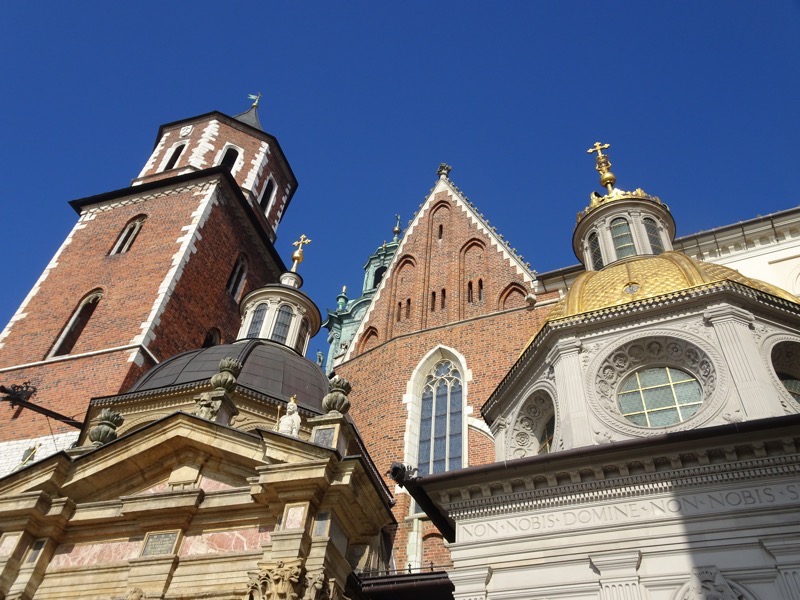
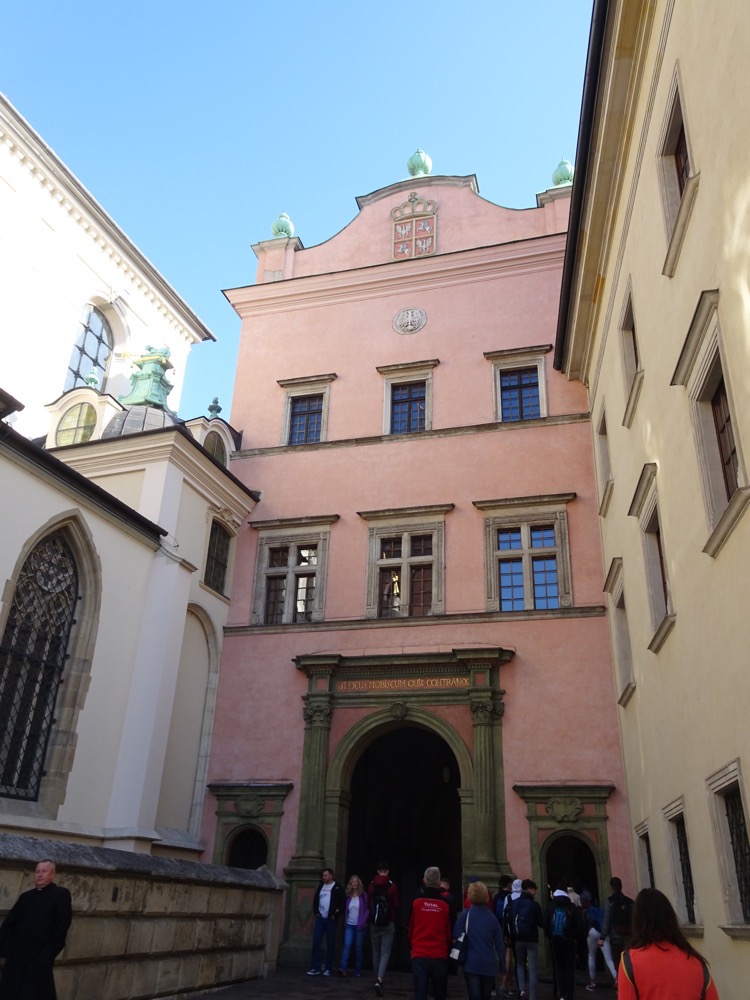 Main courtyard.
Main courtyard.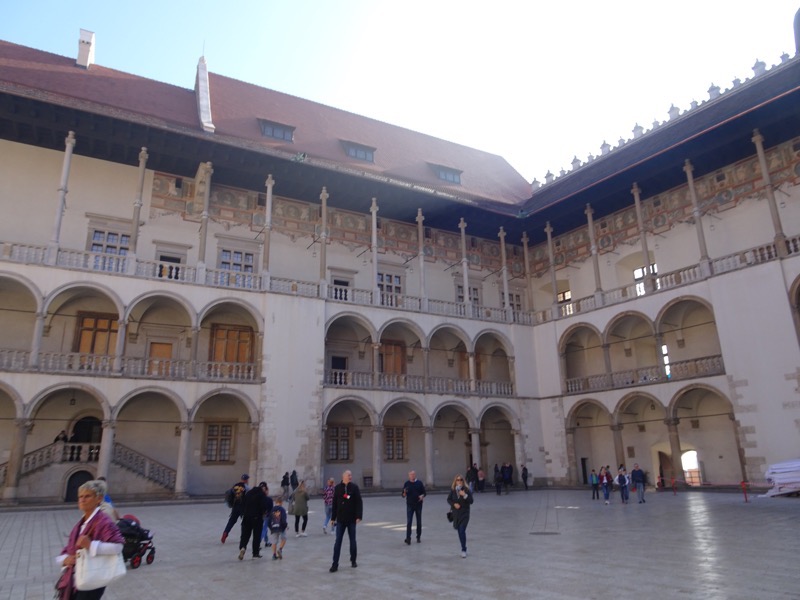 And that, my friends, is pretty much the limit of the photos I was able to take at Wawel Castle. The castle contains an important collection of Renaissance art, some Ghirlandaio, Cranach, at least two Rubens, a Tintoretto, Tiepolo, and a few Dossi among others; lots of famous pieces, but NO PHOTOGRAPHY was allowed:
And that, my friends, is pretty much the limit of the photos I was able to take at Wawel Castle. The castle contains an important collection of Renaissance art, some Ghirlandaio, Cranach, at least two Rubens, a Tintoretto, Tiepolo, and a few Dossi among others; lots of famous pieces, but NO PHOTOGRAPHY was allowed:
https://en.wikipedia.org/wiki/File:Domenico_Ghirlandaio_008.jpg
https://en.wikipedia.org/wiki/File:Cranach_the_Elder_Christ_blessing_the_children.jpg
https://en.wikipedia.org/wiki/File:Rubens_W%C5%82adys%C5%82aw_Vasa_(detail).jpg
https://en.wikipedia.org/wiki/File:Giovanni_Battista_Tiepolo_097.jpg
The castle also contains a famous collection of Gobelin tapestries known as the Sigismund II Augustus tapestry collection, a collection of Crown jewels and coronation pieces, a very impressive armoury and many period household furnishings – chairs, trunks, tables, light fittings, fireplaces, and smaller domestic items like jugs, plates, bowls etc. It is a huge loss not to be able to photograph these things, as they never appear in catalogues or books.
The armoury, in particular, was extremely frustrating, there was an enormous collection of polearms, swords, crossbows, early firearms and daggers – and NONE of it was well marked. Honestly, they had a wall of about 30 daggers with a tag that read something like “Daggers from Austria, Germany, Italy, France, and Spain; 14th to 16th century”. I could take a stab at the provenance of some of them, but it was really annoying to know each of these artefacts have a unique origin and history, but the primary goal of the curators of the museum seems not to be one of education, but of traffic flow. Most of the rooms we accessed were of a similarly poorly labelled – you enter an enormous chamber, surrounded by tapestries, paintings, obviously period furniture items, there is one small A3 plaque with six people huddled around it trying to figure out which item is which using the shoddily numbered diagram, with very little information. Honestly, whoever set this place up cares not a whit for educating those that visit.
We walked out after having seen some of the most wonderful objects, with no photos to share with other medieval enthusiasts back home, and zero information on what we had been looking at. We hightailed it to the two bookshops and found only the most basic of touristy guidebooks – you know the one, it is basically the Wikipedia page of the castle in print form. So disappointed. I asked one of the staff members if there was a book on the armoury, and he didn’t even know if there was one. We eventually found a very weighty academic 300-page tome solely addressing polearms, but not just ones in the Wawel Castle collection, when I was really interested in the crossbows and early firearms.
If you are going to prohibit guests from taking photographs, then for crying out loud sell decent guidebooks to the various exhibits. It’s just such a let down to travel halfway around the world to see these magnificent things and not to be able to recall them or share them. Particularly from a research and education standpoint. This must be one of the most frustrating and disappointing museum visits I have ever encountered.
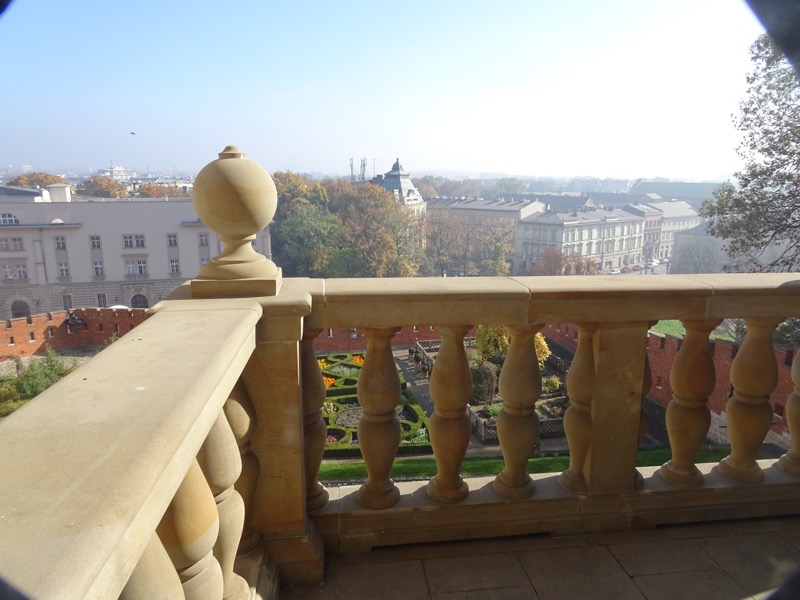
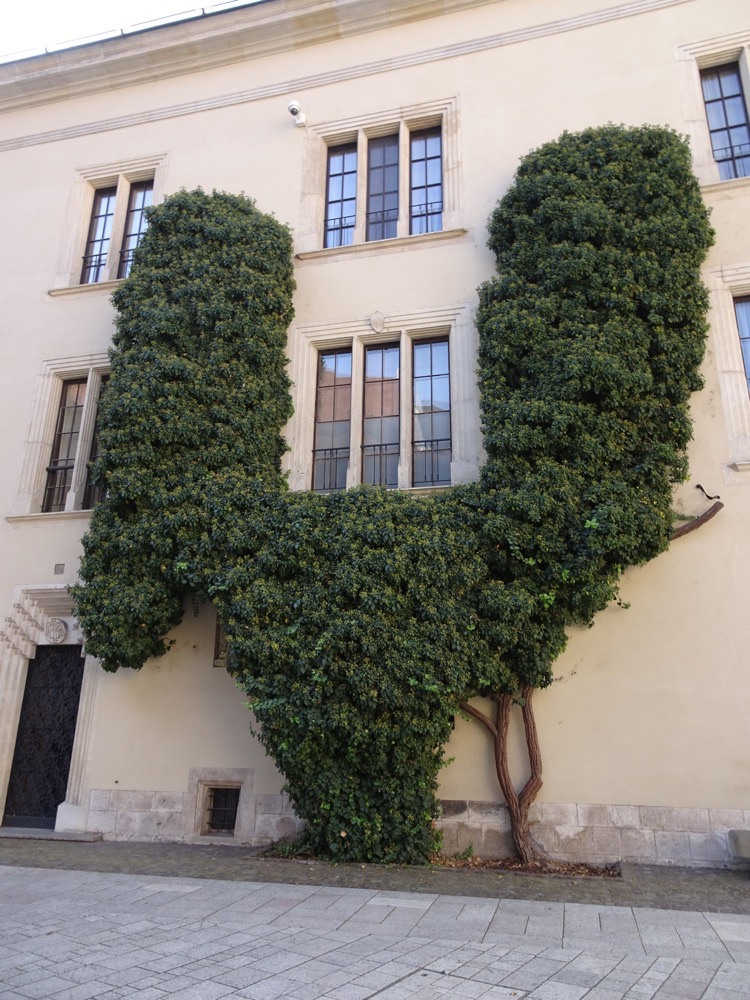 On more than one occasion we saw small groups entering rooms that we weren’t allowed to enter because they were on an organised tour. Museums should not be like this. It is a cluster. My advice for anyone planning on attending Wawel Castle is to set aside the entire day for it so you can visit on their scheduled time slots. I would probably also use a private tour operator to access the ‘non-public’ spaces… and I’d probably anticipate a disappointing visit anyway due to photography not being allowed, and the lack of decent books to make up for the whole photography is not allowed thing. :/
On more than one occasion we saw small groups entering rooms that we weren’t allowed to enter because they were on an organised tour. Museums should not be like this. It is a cluster. My advice for anyone planning on attending Wawel Castle is to set aside the entire day for it so you can visit on their scheduled time slots. I would probably also use a private tour operator to access the ‘non-public’ spaces… and I’d probably anticipate a disappointing visit anyway due to photography not being allowed, and the lack of decent books to make up for the whole photography is not allowed thing. :/ 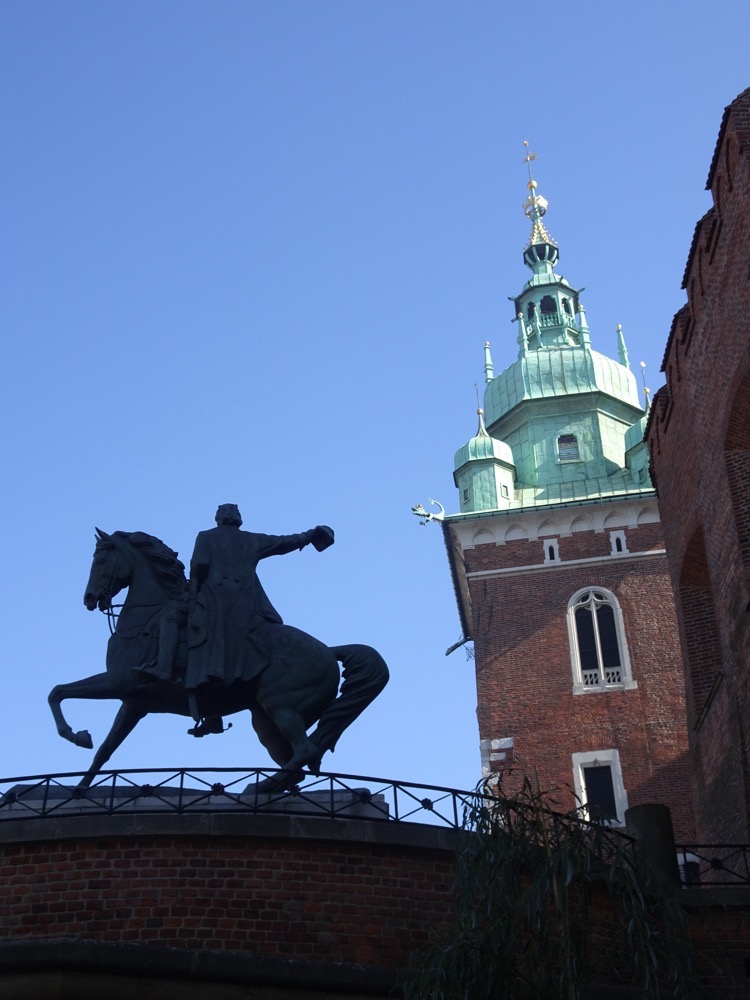
After grabbing a quick and dirty roadside bite to eat we head out to the countryside about an hour south of Krakow to Oświęcim to visit the Auschwitz-Birkenau museums and memorials. I have based a lot of the following text on information boards that were dotted around the complex. I have found it hard to find my own words to express what happened here, and how it makes you feel as you progress through this very important historical site. So I have paraphrased a lot of the more thoughtful words that have been placed before us for our introspection as we visited.
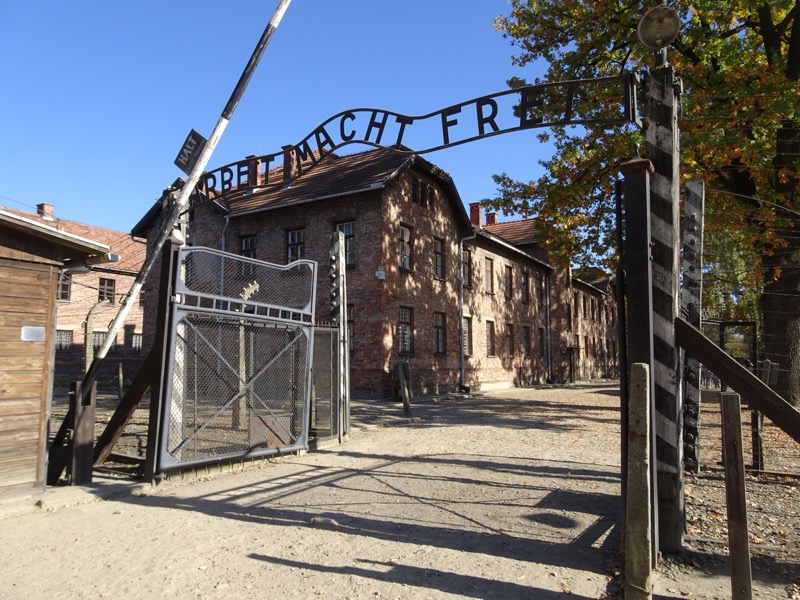 Throughout the world, Auschwitz has become a symbol of terror, genocide and the Holocaust. The German forces occupying Poland during the Second World War established a concentration camp on the outskirts of the town of Oświęcim in 1940. The Germans called the town, ‘Auschwitz’ and that is the name by which the camp was known. Over the next years it was expanded into three main camps: Auschwitz I, Auschwitz II- Birkenau and Auschwitz III- Planowitz with more than 40 subcamps in the area. The first people to be brought to Auschwitz as prisoners and murdered here were Poles. They were soon followed by Soviet prisoners of war, Gypsies, and deportees from other nationalities. Beginning in 1942, however, Auschwitz became the setting of the most massive murder campaign in history, when the Nazis put into operation their plan to destroy the entire Jewish population of Europe. The great majority of Jews who were deported to Auschwitz – men, women and children – were sent immediately upon arrival to deal in the gas chambers of Birkenau.
Throughout the world, Auschwitz has become a symbol of terror, genocide and the Holocaust. The German forces occupying Poland during the Second World War established a concentration camp on the outskirts of the town of Oświęcim in 1940. The Germans called the town, ‘Auschwitz’ and that is the name by which the camp was known. Over the next years it was expanded into three main camps: Auschwitz I, Auschwitz II- Birkenau and Auschwitz III- Planowitz with more than 40 subcamps in the area. The first people to be brought to Auschwitz as prisoners and murdered here were Poles. They were soon followed by Soviet prisoners of war, Gypsies, and deportees from other nationalities. Beginning in 1942, however, Auschwitz became the setting of the most massive murder campaign in history, when the Nazis put into operation their plan to destroy the entire Jewish population of Europe. The great majority of Jews who were deported to Auschwitz – men, women and children – were sent immediately upon arrival to deal in the gas chambers of Birkenau.
When the SS realized that the end of the war was near, they attempted to remove the evidence of the atrocities committed here. They dismantled the gas chambers, crematoria, and other buildings, burned documents and evacuation all those prisoners who could walk to the interior of Germany. Those who were not evacuated were liberated by the Red Army on January 27, 1945.
On July 2, 1974, the Polish Parliament established the State Museum of Oświęcim – Brezinka on the sites of the former camps at Auschwitz I and Auschwitz II-Birkenau. In 1979, these camps were formally recognized by UNESCO by their inclusion on the World Heritage List.
In the years 1940 – 1941 German occupants expelled the Polish inhabitants of the following villages: Brzezinka, Harmęże, Pławy, Bór, Rajsko, Klucnikowice, Babice Broszkowice and from Zasole District of Oświęcim. They took this land and founded the death camp Auschwitz-Birkenau. The camp’s economic and industrial base is on the site of the demolished or taken buildings from those villages.
Auschwitz was the largest Nazi German Concentration Camp and Death Camp. In the years 1940 – 1945, the Nazis deported at least 1,300,000 people to Auschwitz:
1,100,000 Jews
140,000 – 150,000 Poles
23,000 Roma (Gypsies)
15,000 Soviet Prisoners of War
25,000 Prisoners from other ethnic groups.
1,100,000 of these people died in Auschwitz, approximately 90% of the victims were Jews. The SS murdered the majority of these people in the gas chambers.
Model of the massive L-Shaped gas chamber and crematoria complex located at Auschwitz-Birkenau. 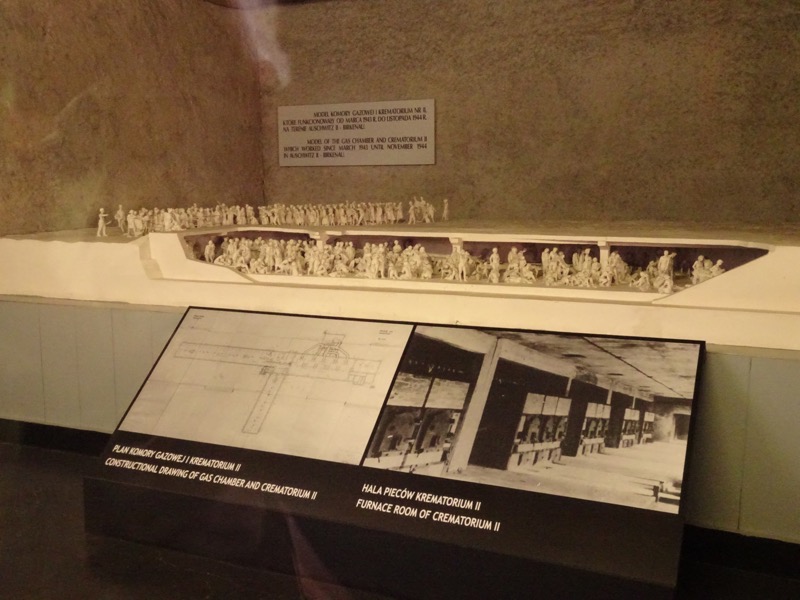
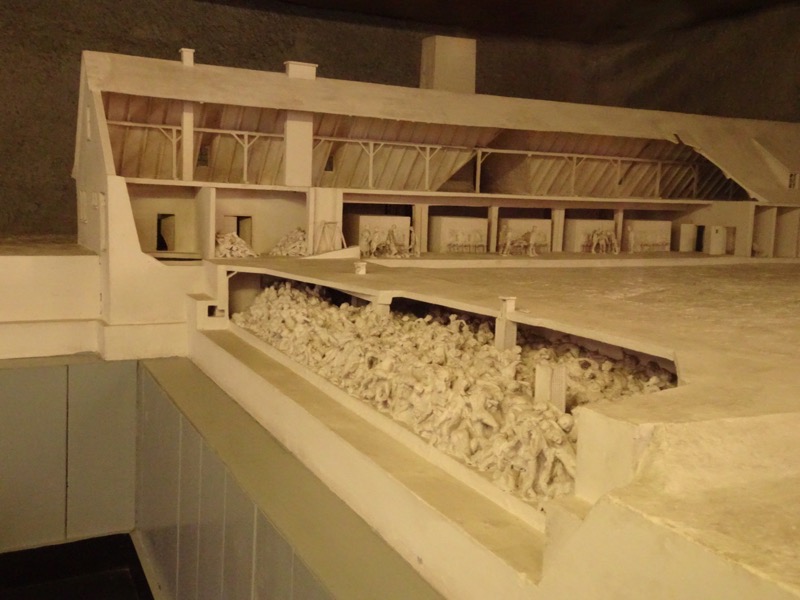
Transports of Jews deported to Auschwitz would arrive at a specially constructed railway ramp at Birkenau. The ramp was obscured from the camp so that prisoners could not see arriving deportees and deportees could not see the state of the prisoners. At this unloading ramp, women and children were immediately separated from men. Subsequently, SS doctors would carry out an extremely perfunctory ‘selection’. Those who were considered fit for work were directed to the work camp to be registered as prisoners. This amounted to approximately 25 per cent of the arrivals. The remainder were led directly to the gas chambers. In order to avoid panic spreading, people condemned to death were assured that they were going to take a shower after their train travel for disinfection purposes. Sometimes entire trainloads of deportees were directed straight to the gas chambers without any selections taking place.
A map covering part of the Auschwitz-Birkenau concentration camp and death camp. The yellow area is a series of warehouses known as ‘Kanada’ in Auschwitz II-Birkenau, the red area is the ‘Kanada’ of the Auschwitz KL camp (I will come back to them later). 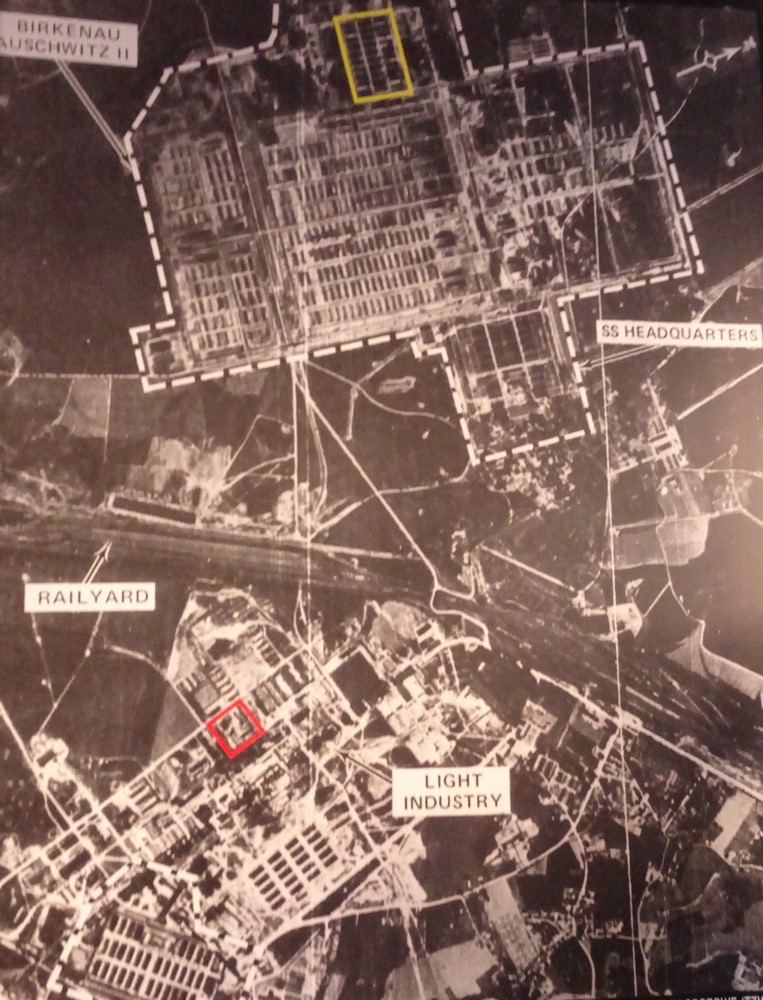 After the selection process on the railway platform, those who were going to be murdered in the gas chambers were assured that they were going to take a shower. They were divided from their belongings and made to strip naked. Fake showerheads were fixed to the ceiling of the gas chambers.
After the selection process on the railway platform, those who were going to be murdered in the gas chambers were assured that they were going to take a shower. They were divided from their belongings and made to strip naked. Fake showerheads were fixed to the ceiling of the gas chambers.
Beaten and intimidated by SS dogs, 2,000 victims were crammed into the underground chamber, an area of approximately 210M2. The chamber door would be locked and Zyklon B was poured into the chamber from holes in the ceiling. The bodies were then stripped of gold teeth and jewellery as war spoils for the Reich, their hair was cut off and sold to PKR textiles manufacturer to be made into bedding, clothing etc, then the bodies were burnt in the crematorium. All the victims’ personal documents were destroyed, effectively erasing all evidence of that person having been executed there.
In Barracks numbered 5 – 10, contains items relating to the atrocities committed on this site by the Nazis. They have been assembled to demonstrate to visitors the extent of the mass extermination of the predominantly Jewish prisoners at the camp.
Zyklon B canisters found on site after liberation: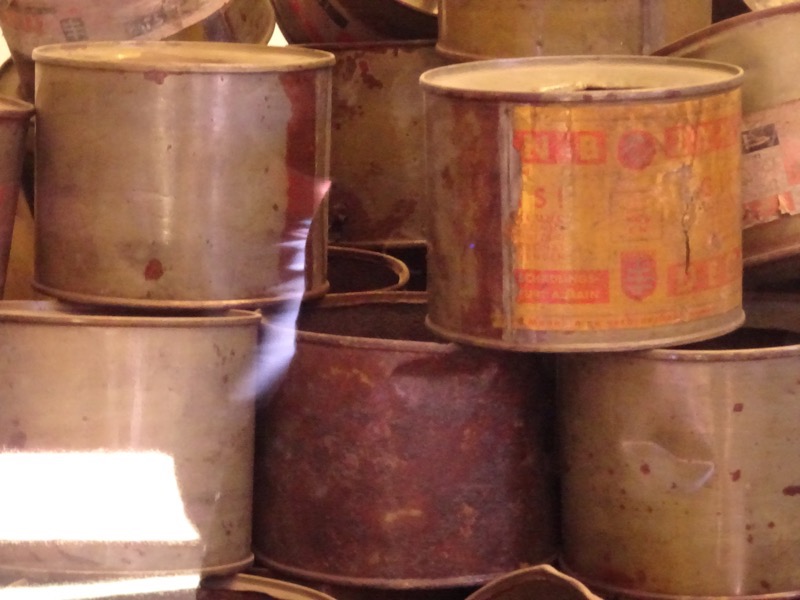
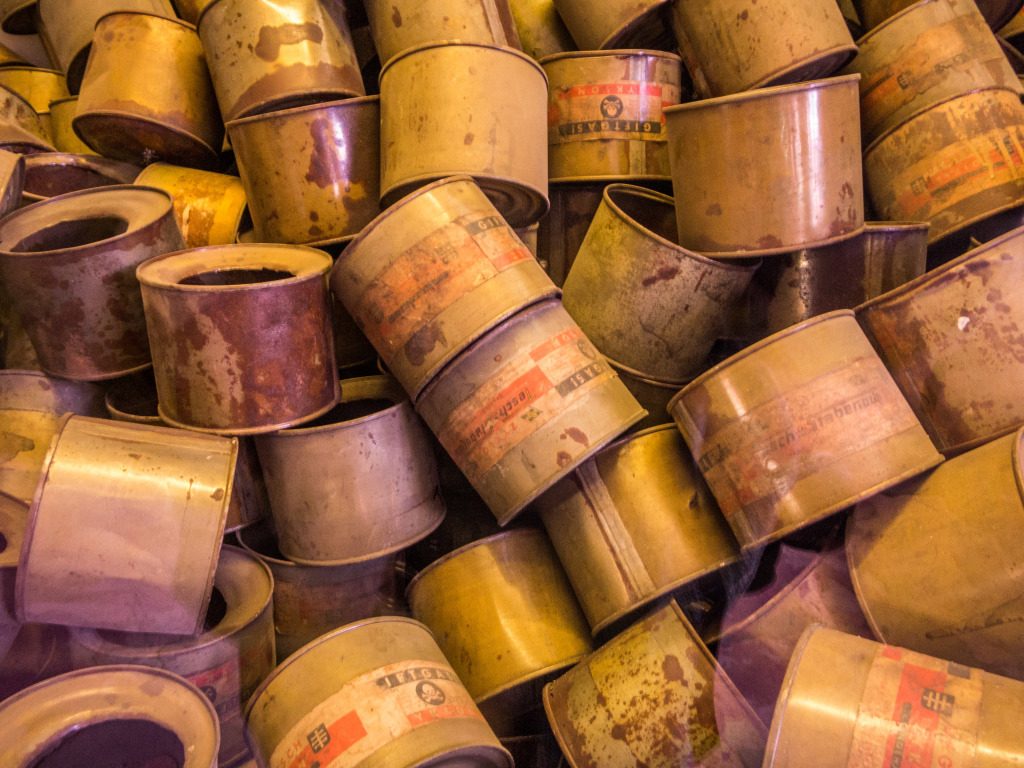 Piles of spectacles removed from deportees who were murdered in the gas chambers.
Piles of spectacles removed from deportees who were murdered in the gas chambers.
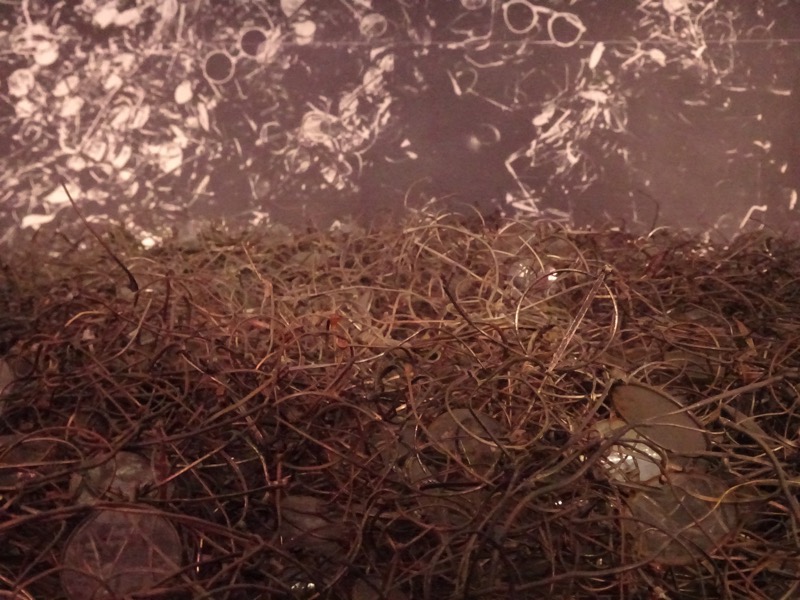
Timeline:
June 1940 – Beginning of the deportation of Poles, the Nazis sent 140,000 – 150,000 Polish prisoners to the camp, where half of them perished.
June 1941 – Beginning of deportations of 25,000 prisoners of various nationalities, about half of these prisoners perished in the camp.
Summer 1941 – Beginning of deportations of 15,000 Soviet POWs. Most died during their imprisonment. Only a few survived.
March 1942 – Beginning of deportations of 1.1million Jews. Auschwitz started fulfilling two functions; whilst remaining a concentration camp, it became yet another site of the Holocaust, the biggest mass murder in the history of mankind, perpetrated by the Nazis. About one million deported Jews, were murdered by the SS, mainly in gas chambers.
February 1943 – Beginning of deportations of 23,000 Roma (Gypsies), of this number, 21,000 perished.
One thing these disparate groups had in common was that any disabled people who arrived at the camp would be immediately set to the death chambers. They were identified during the selection process and never registered as prisoners.
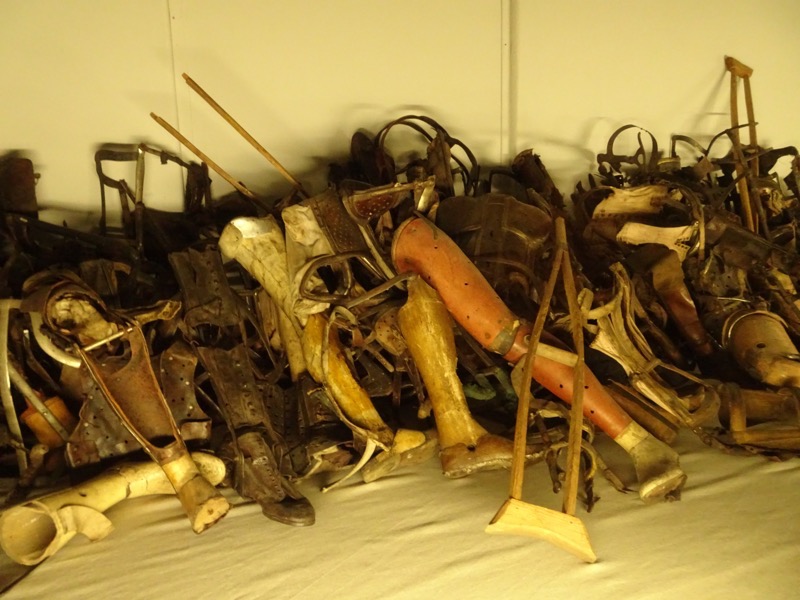
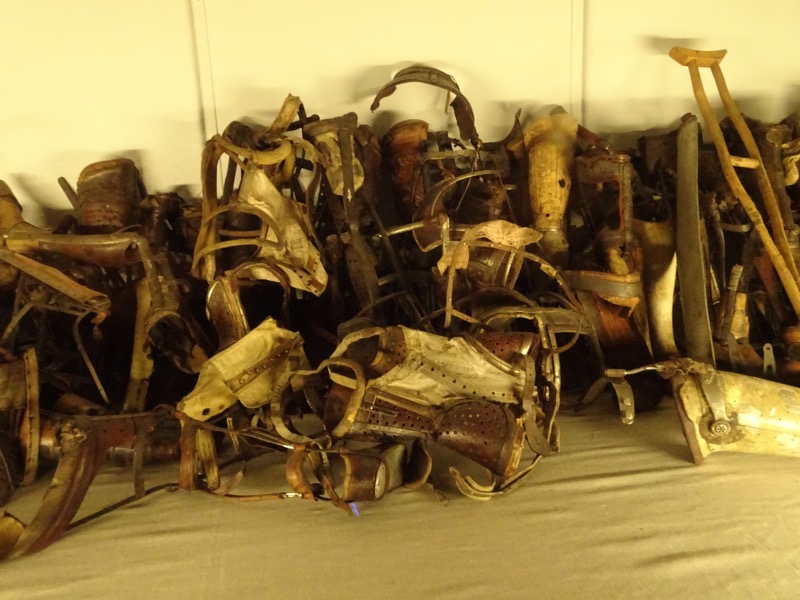 People arriving at the camps had many personal belongings with them that were taken and sorted, including household goods and kitchen items:
People arriving at the camps had many personal belongings with them that were taken and sorted, including household goods and kitchen items:
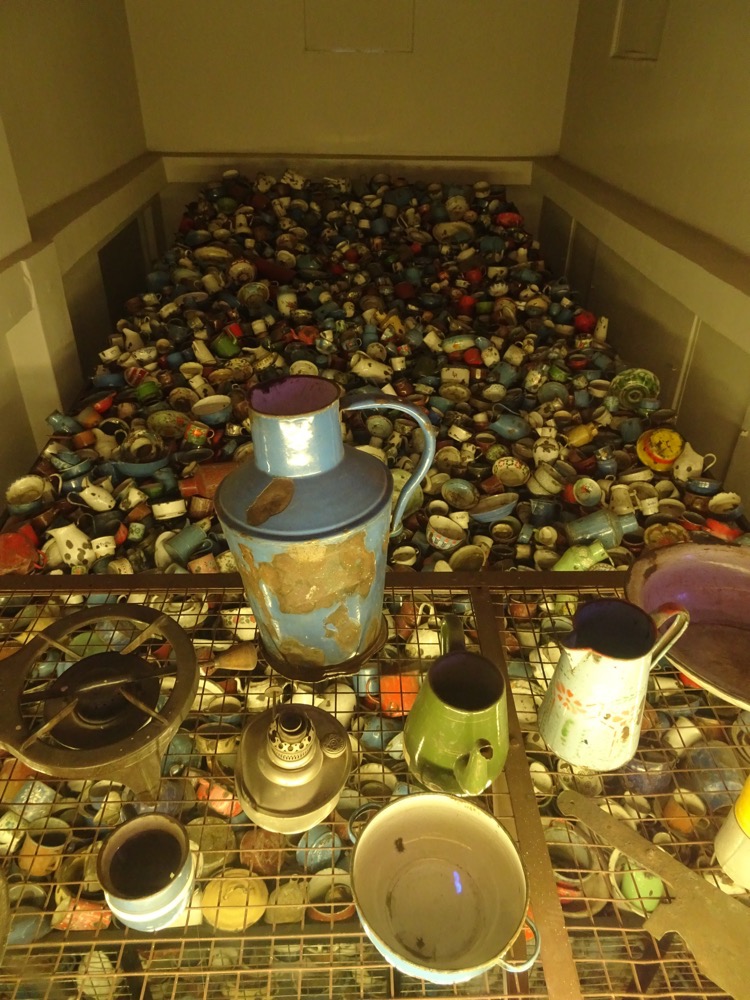 Piles of suitcases each one once carrying the entire worldly goods of a deportee:
Piles of suitcases each one once carrying the entire worldly goods of a deportee: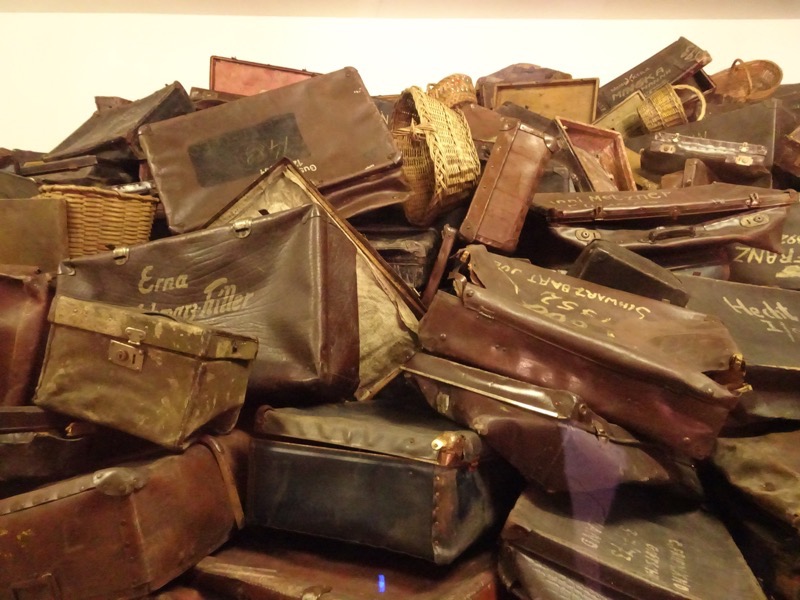
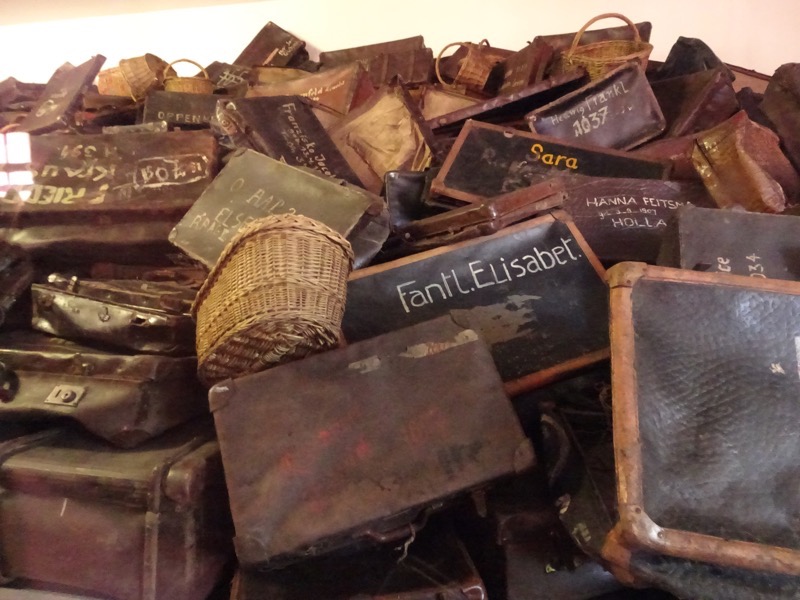 Mountains of shoes taken from the dead or about to be killed:
Mountains of shoes taken from the dead or about to be killed:
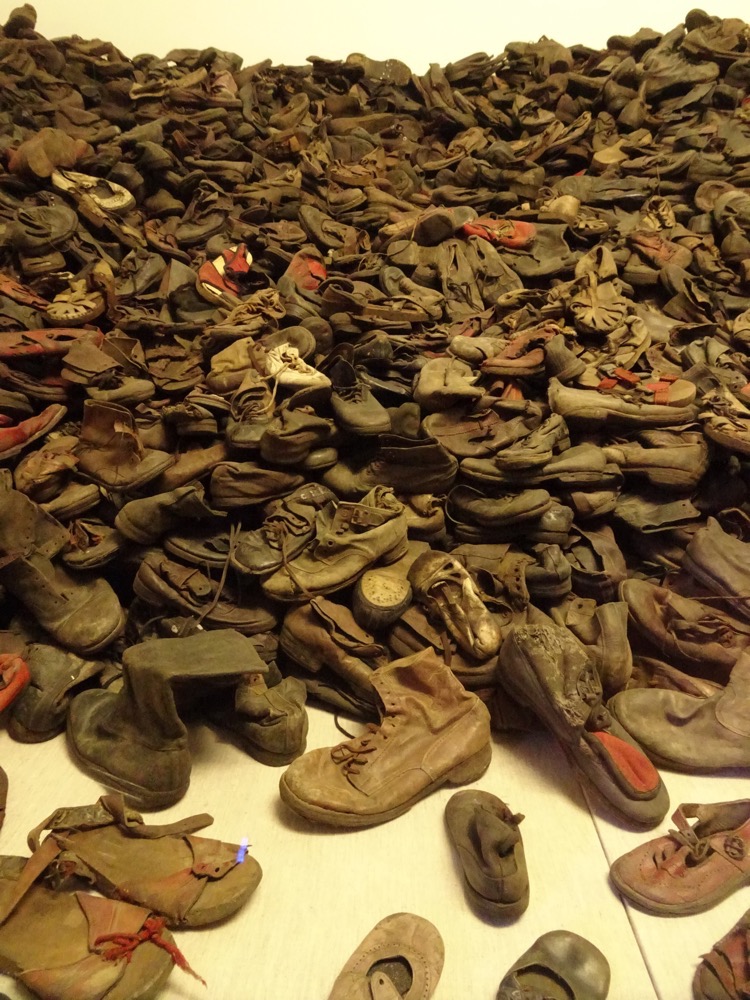 The shoes of children who were murdered at the camps:
The shoes of children who were murdered at the camps:
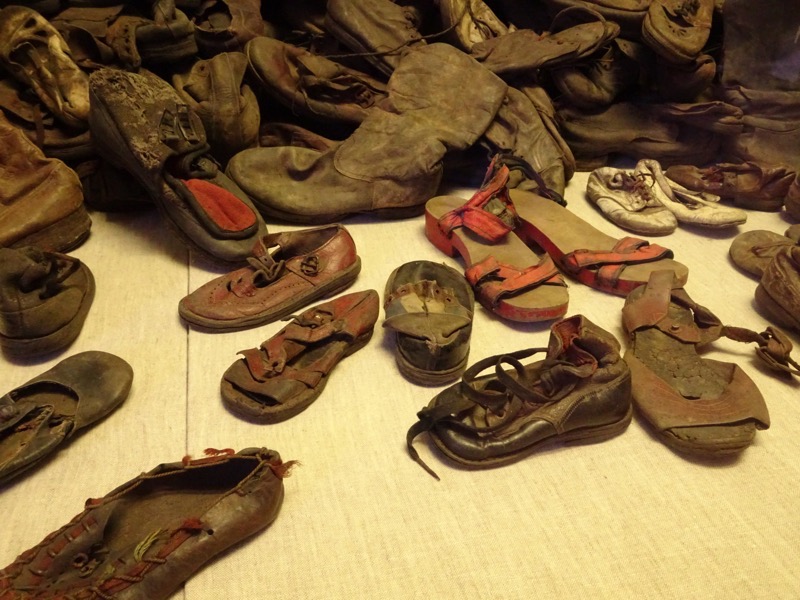 Personal brushes and shaving brushes:
Personal brushes and shaving brushes: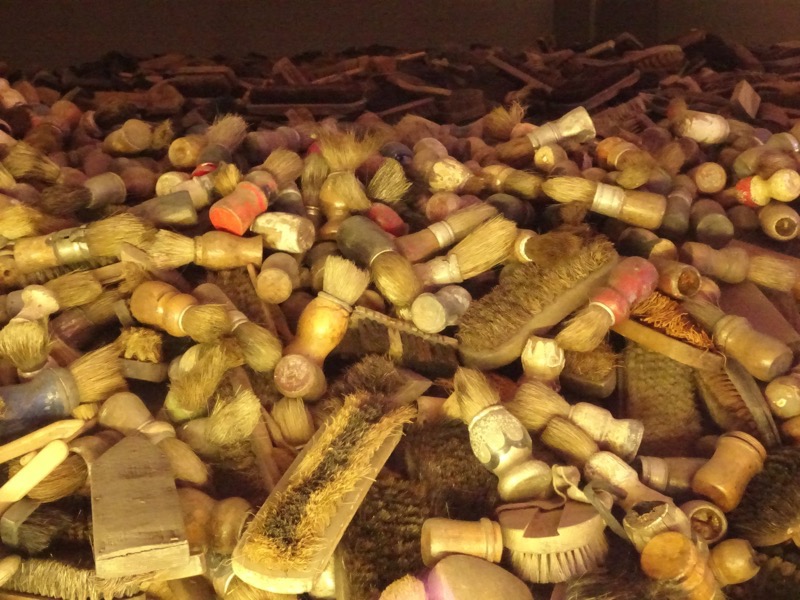
When the camp was first administered, every prisoner who arrived at Auschwitz would have an identification number given to them and a card made with three photographs of the individual for identification. This photography system proved time-consuming and expensive and as many prisoners did not survive the camp long enough to justify the process. KL Auschwitz was the only Nazi camp where prisoners had their camp numbers tattooed onto their person – on their left arm, though some smaller children had numbers tattooed onto their legs. The tattooing saved money due to the right mortality rate and assisted with difficulties in identifying corpses. From Autumn 1941 Soviet prisoners of war as well as other groups, were tattooed also. From Spring 1943, tattooing for identification was used to mark all prisoners.
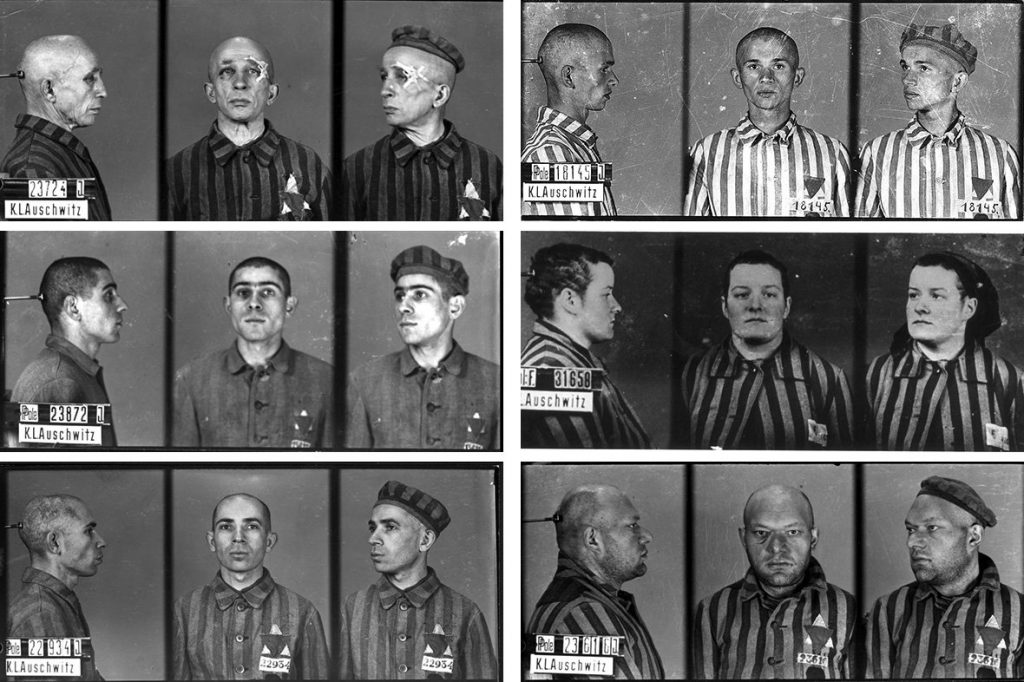 Camp uniforms were issued to prisoners who made it through the selection process to become registered prisoner/workers. They were often filthy and lice-ridden.
Camp uniforms were issued to prisoners who made it through the selection process to become registered prisoner/workers. They were often filthy and lice-ridden.
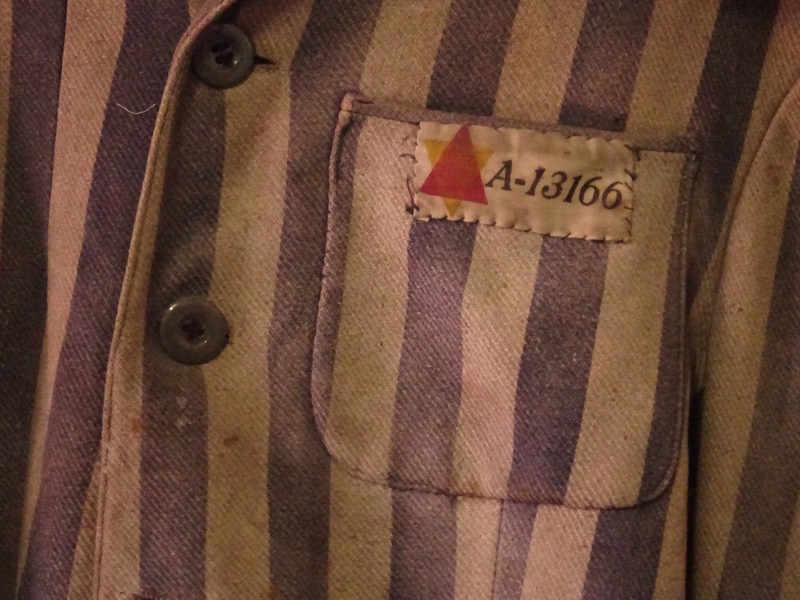 Each of these people had a family, an occupation, a home. Here, they were dehumanized and turned into a number only.
Each of these people had a family, an occupation, a home. Here, they were dehumanized and turned into a number only. 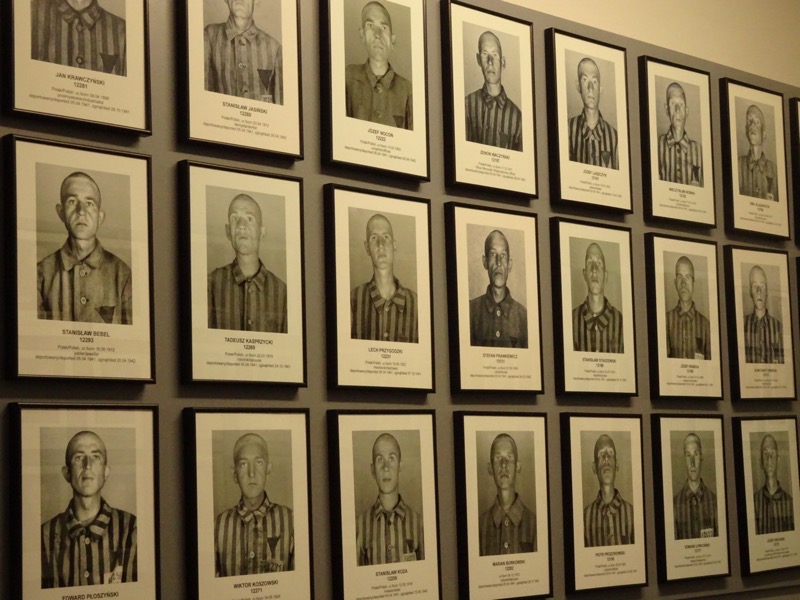
the windows of the barracks were the constant reminders of the failure to comply with orders. Barbed wire fences, guard towers and the ever-present threat of violence and death.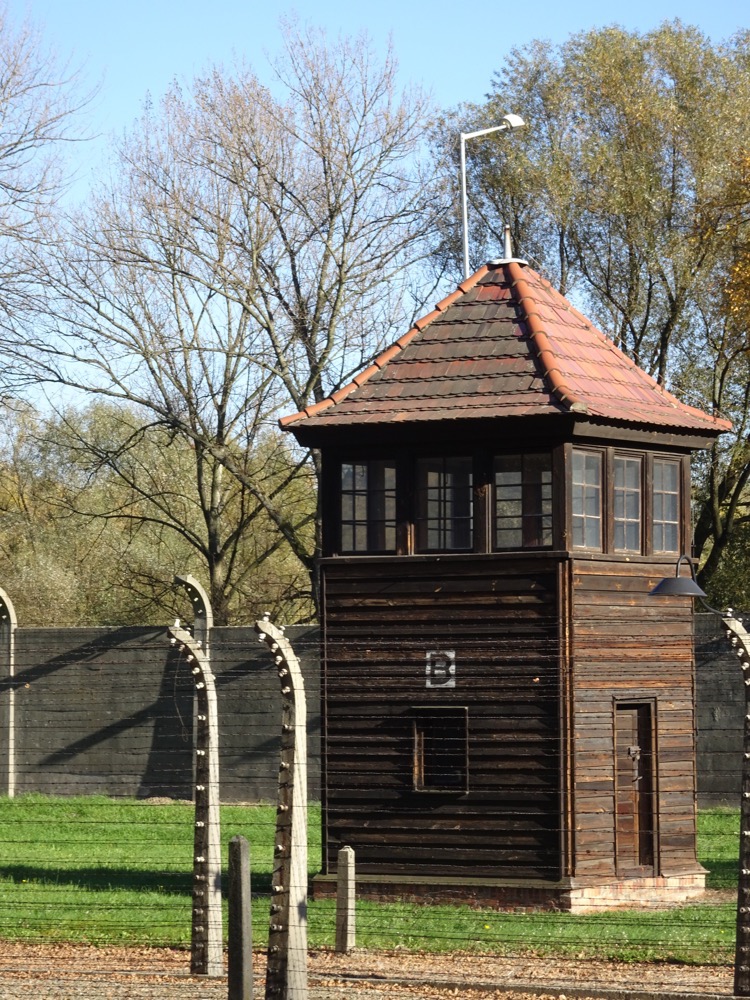
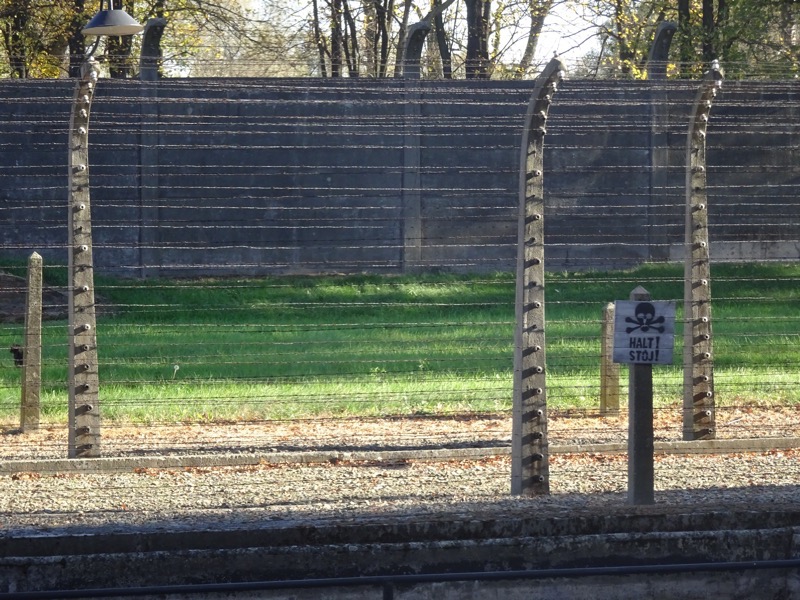
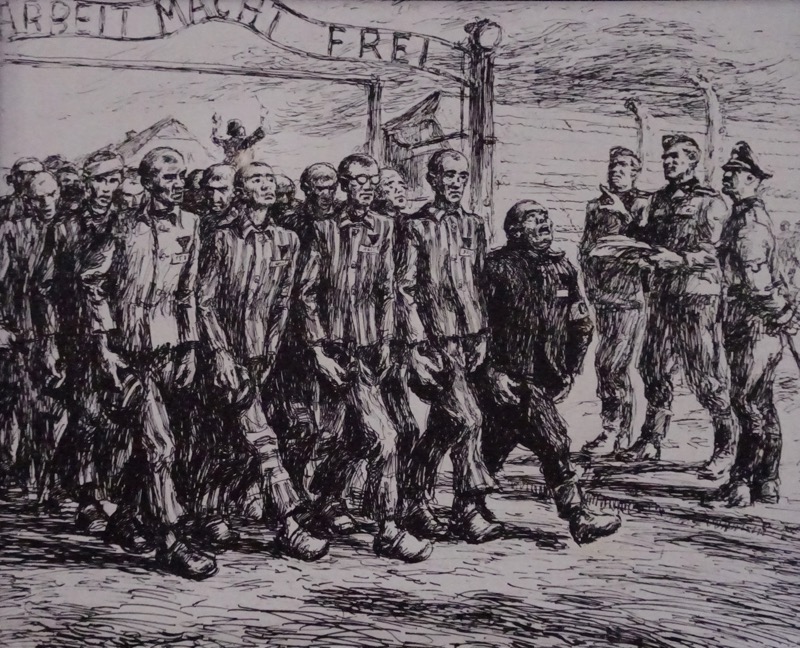
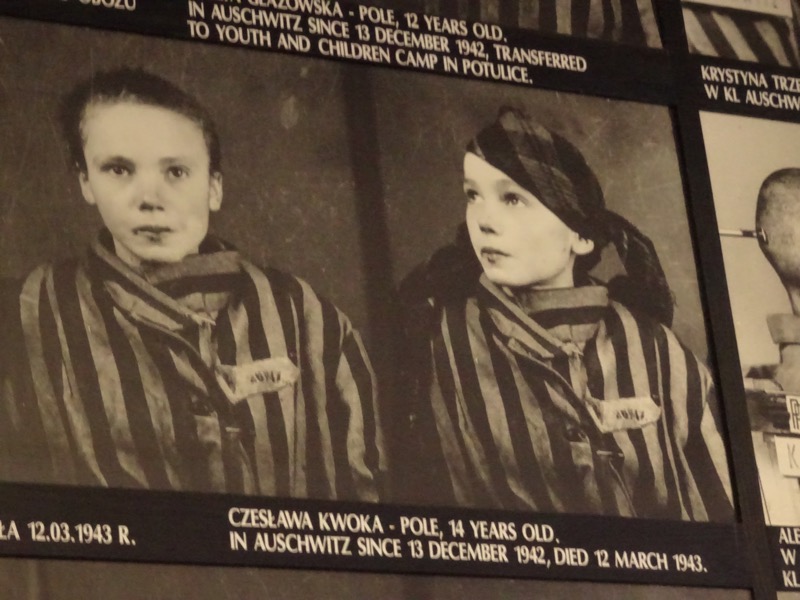
Prisoners held in the concentration camp died from being overworked, from starvation, from deliberately sadistic punishments, from sheer exhaustion at prolonged roll-calls, by being tortured, from appalling living conditions, by being used for medical experiments or through arbitrary executions. Those too weak, or too sick to work were selected by the SS during the roll-calls, or in the infirmary, and either sent to the chambers for extermination or murdered with an injection of phenol.
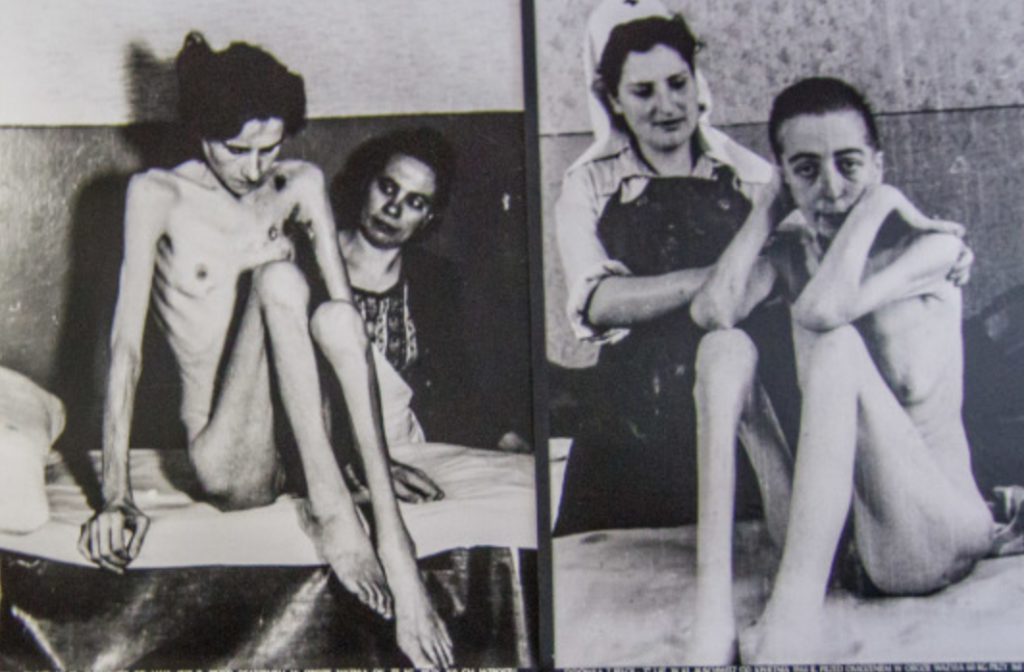
Constant starvation was one of the main factors in the degradation and extermination of prisoners. The daily food ration of each prisoner consisted of approximately 1,200-1,700 kilocalories. Most prisoners had to survive on these rations whilst working approximately 11 hours every day. Prisoners who could not find any additional sources of food usually died after just a few months imprisonments in the camp.
For all their claims to the contrary, the Nazis deported several hundred thousand children to the concentration camps. The Nazis deported about 232,000 children and young people to KL Auschwitz, including 216,000 Jewish children, 11,000 Roma (Gypsy) children, 3,000 Polish children and 1,000 children of other nationalities. The majority of the children perished in the gas chambers immediately after arrival. However, a ‘lucky’ few who had the right ‘features’ ie: were of desirable Aryan appearance with blonde hair and blue eyes, would be taken from their parents and given to good German families to raise. Altogether about 22,000 children and young people of various nationalities were registered as prisoners at KL Auschwitz, meaning the other 200,000 children who arrived at Auschwitz were killed on arrival. On 27 January 1945, the Red Army soldiers liberated only about 650 children and young people from the camp, of which 450 were under 15 years old.
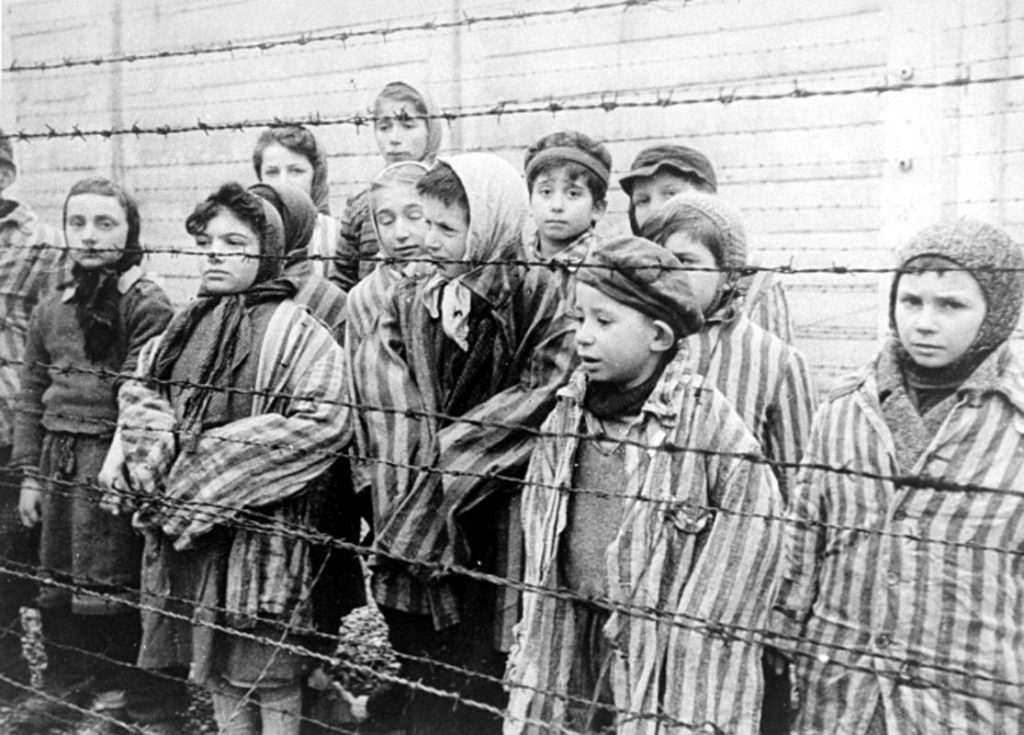
At the time of liberation, there were many children in the camp who were taken there so young as to not know their full names or what towns and regions their families had come from. Many of these children were never reunited with families and several never knew their identities.
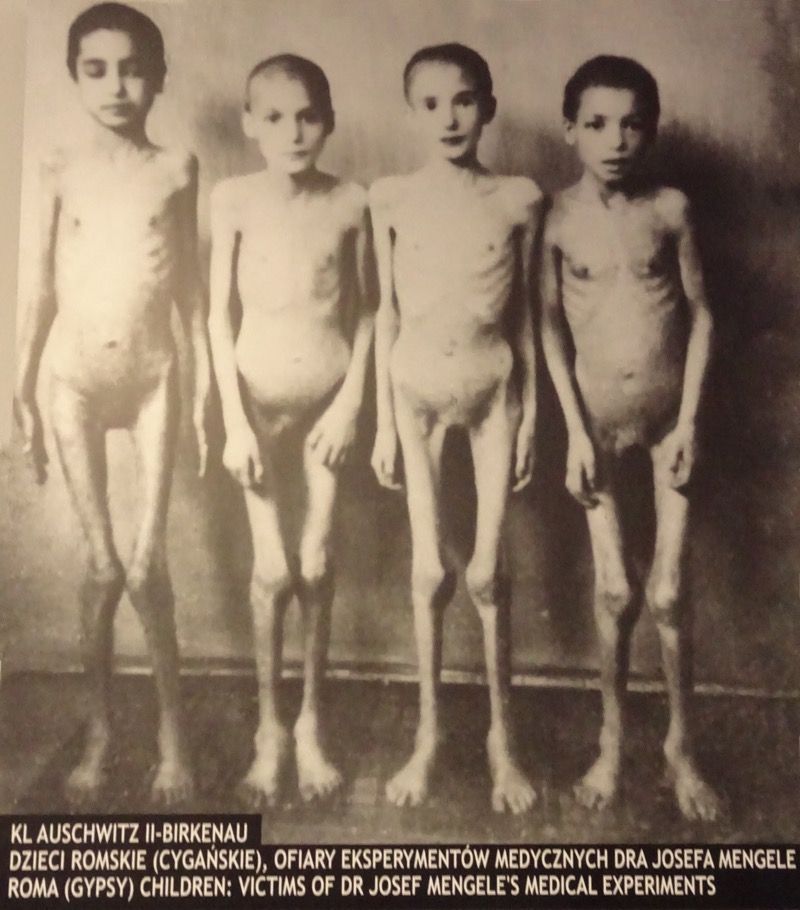
 Map of the Block 11 Punishment Unit. This was effectively the prison within the prison. If prisoner committed offences while in the camp, they could expect any sort of retribution – immediate execution, solitary confinement for a period of time, confinement to starvation with the intention of murdering the prisoner, or face a firing squad at an unknown future time. Note Section 22 in the left hand building – it has what is know as ‘standing cells’ where prisoners entered through a two foot door in a wall and were put in a cell approximatedly two foot square and six foot tall. Prisoners would be locked in this standing cell in complete darkness for indeterminate periods of time.
Map of the Block 11 Punishment Unit. This was effectively the prison within the prison. If prisoner committed offences while in the camp, they could expect any sort of retribution – immediate execution, solitary confinement for a period of time, confinement to starvation with the intention of murdering the prisoner, or face a firing squad at an unknown future time. Note Section 22 in the left hand building – it has what is know as ‘standing cells’ where prisoners entered through a two foot door in a wall and were put in a cell approximatedly two foot square and six foot tall. Prisoners would be locked in this standing cell in complete darkness for indeterminate periods of time.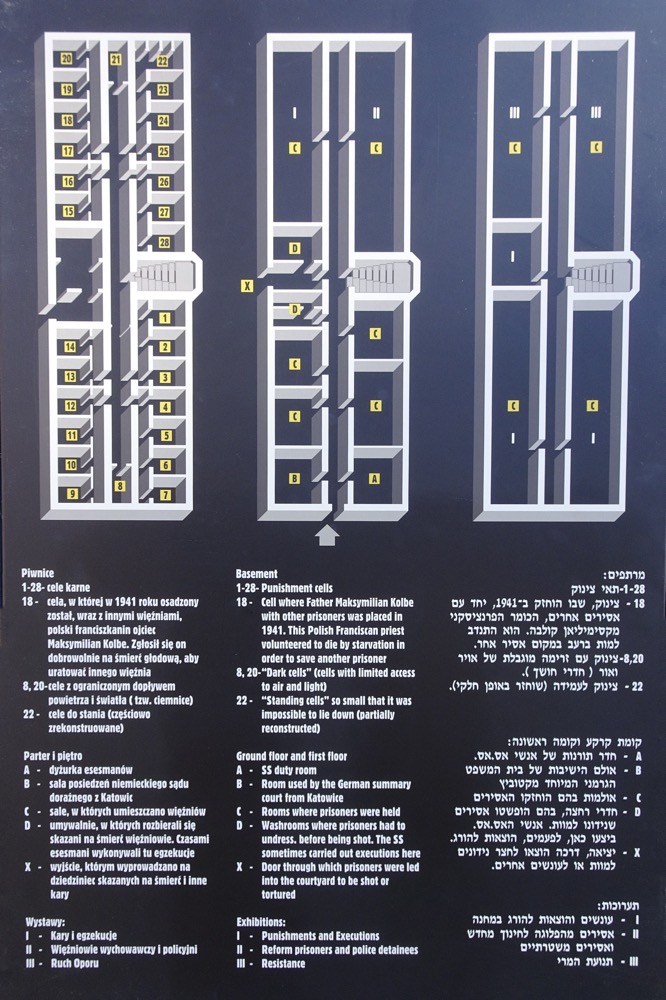 Prisoners were led to this wall for execution by firing squad.
Prisoners were led to this wall for execution by firing squad.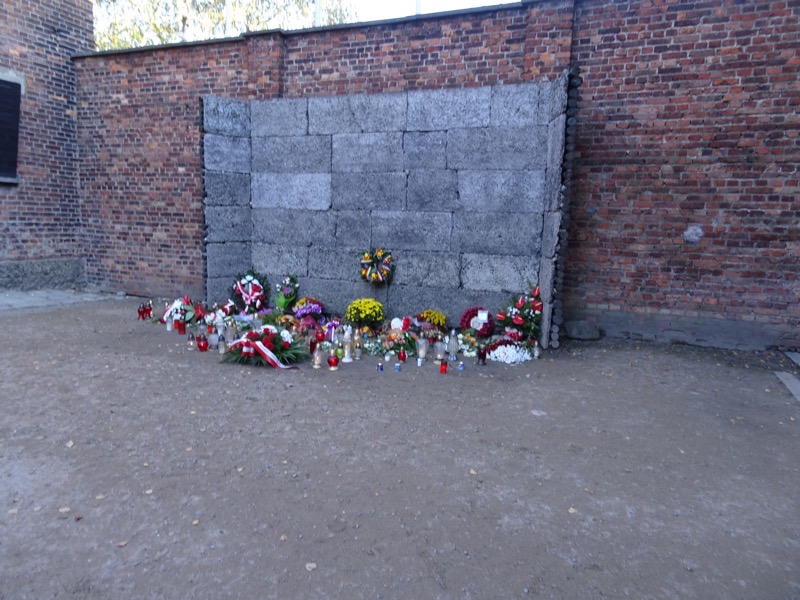
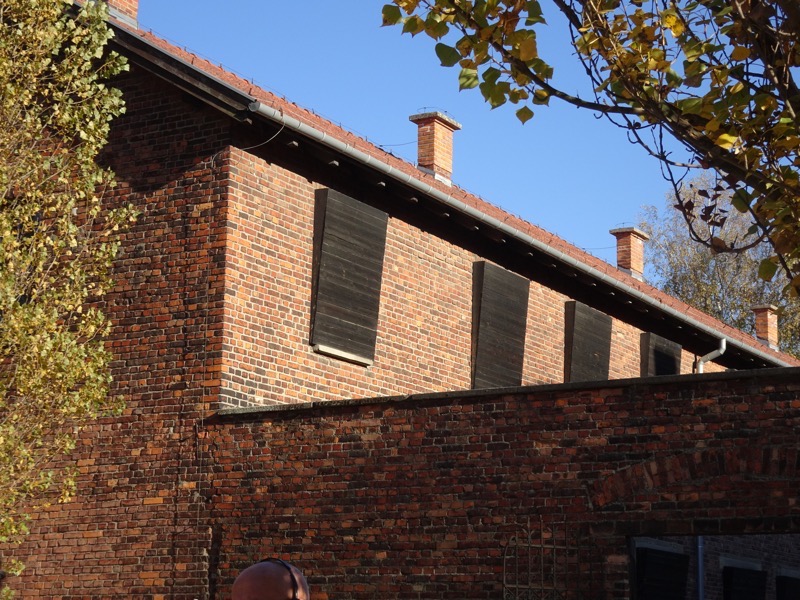 The barracks beside the execution courtyard were blocked from seeing what was happening during the executions. Prisoners avoided having anything to do with Block 11 and tried hard to stay away from it when going about their duties.
The barracks beside the execution courtyard were blocked from seeing what was happening during the executions. Prisoners avoided having anything to do with Block 11 and tried hard to stay away from it when going about their duties.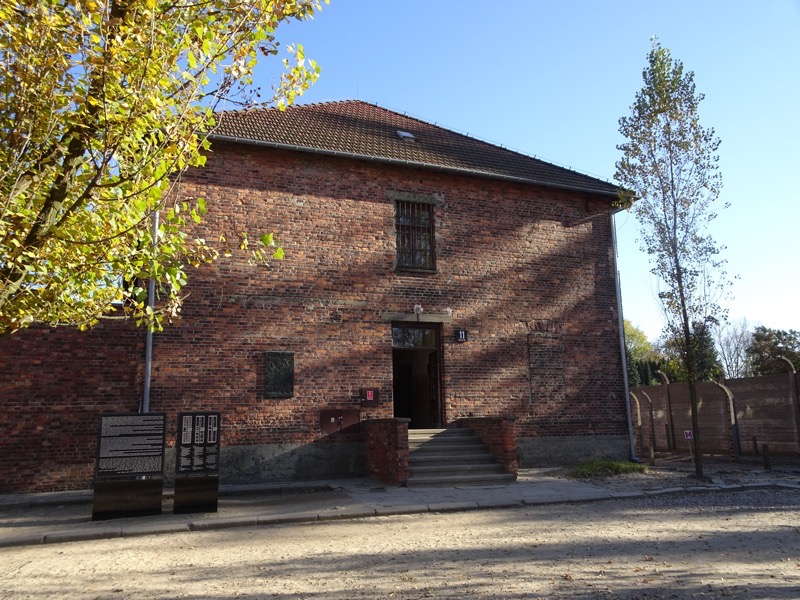 A guardhouse used by SS officials for shelter during the harsh roll-calls that prisoners were forced to endure:
A guardhouse used by SS officials for shelter during the harsh roll-calls that prisoners were forced to endure: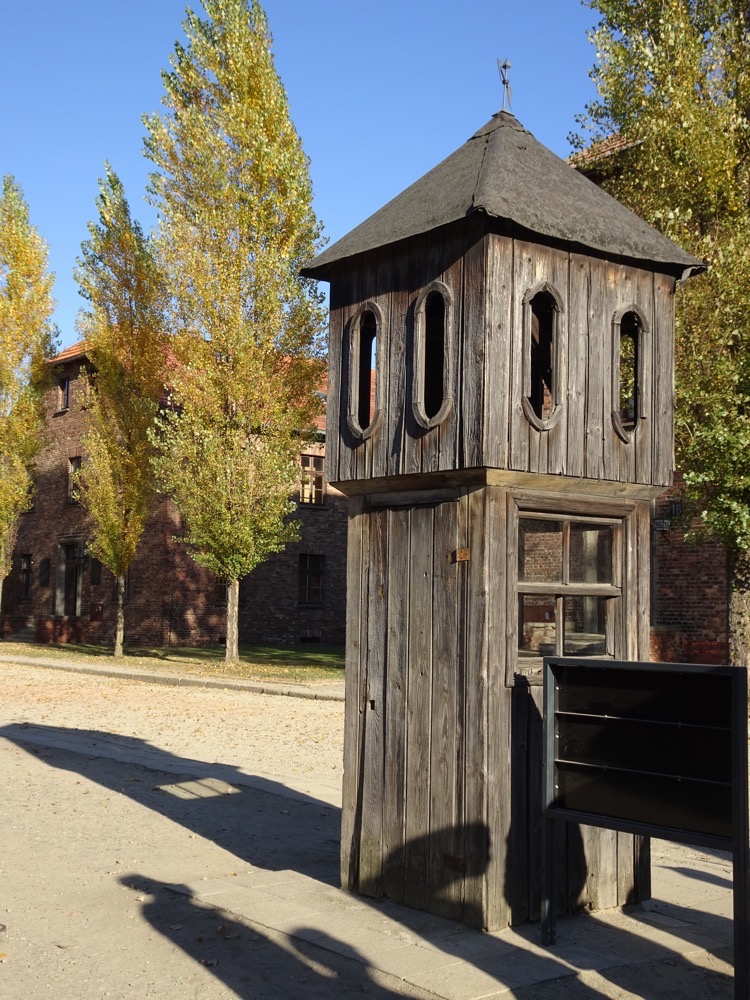
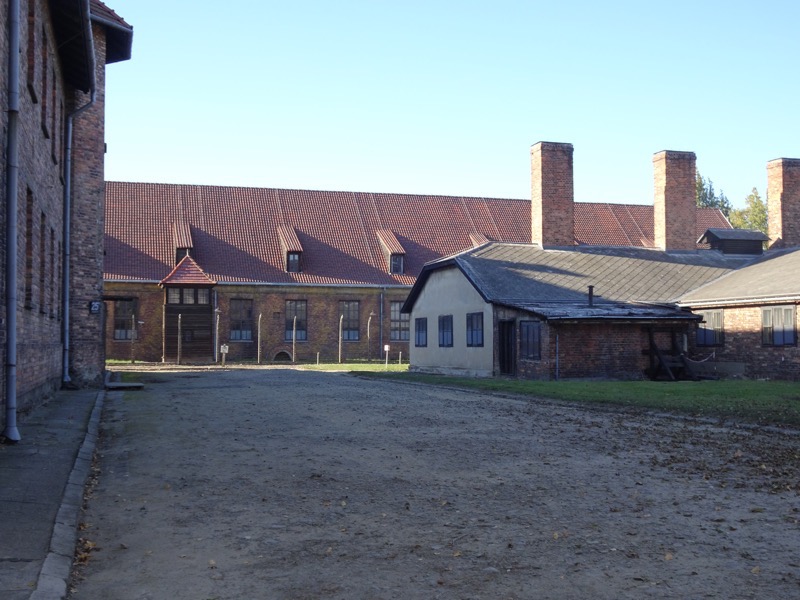 In the centre of Auschwitz KL, the SS officer in charge would hold a roll call in the courtyard above. The roll call contained reports on the number of prisoners present. If there seemed to be anyone missing, prisoners had to continue to stand at attention until the SS were satisfied – regardless of the weather, sometimes for up to twelve hours or more. To intimidate the prisoners, the SS would also conduct public hangings in full view of the roll-call area. The largest such execution was carried out on 19 July 1943 when twelve Poles suspected of helping three other prisoners escape, and of maintaining contacts with the outside world, were hanged together on a purpose-built gallows.
In the centre of Auschwitz KL, the SS officer in charge would hold a roll call in the courtyard above. The roll call contained reports on the number of prisoners present. If there seemed to be anyone missing, prisoners had to continue to stand at attention until the SS were satisfied – regardless of the weather, sometimes for up to twelve hours or more. To intimidate the prisoners, the SS would also conduct public hangings in full view of the roll-call area. The largest such execution was carried out on 19 July 1943 when twelve Poles suspected of helping three other prisoners escape, and of maintaining contacts with the outside world, were hanged together on a purpose-built gallows.
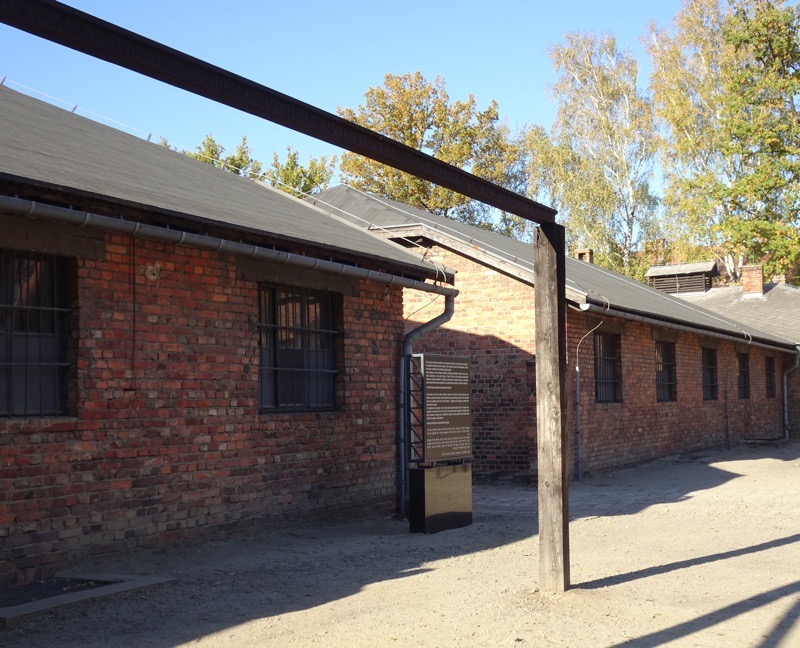

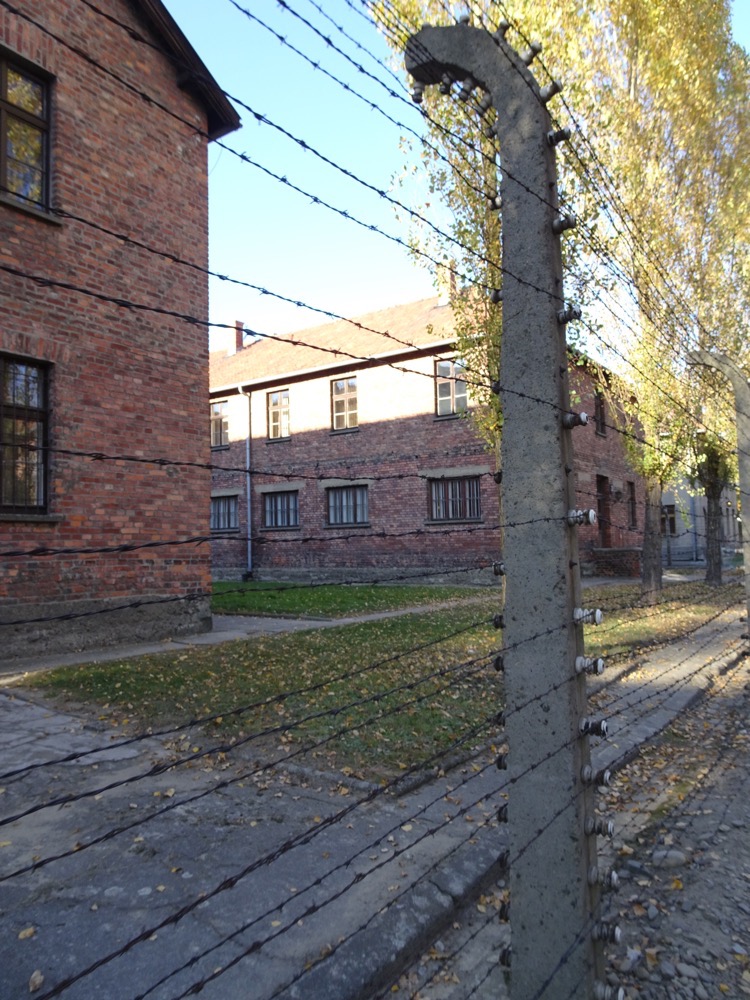
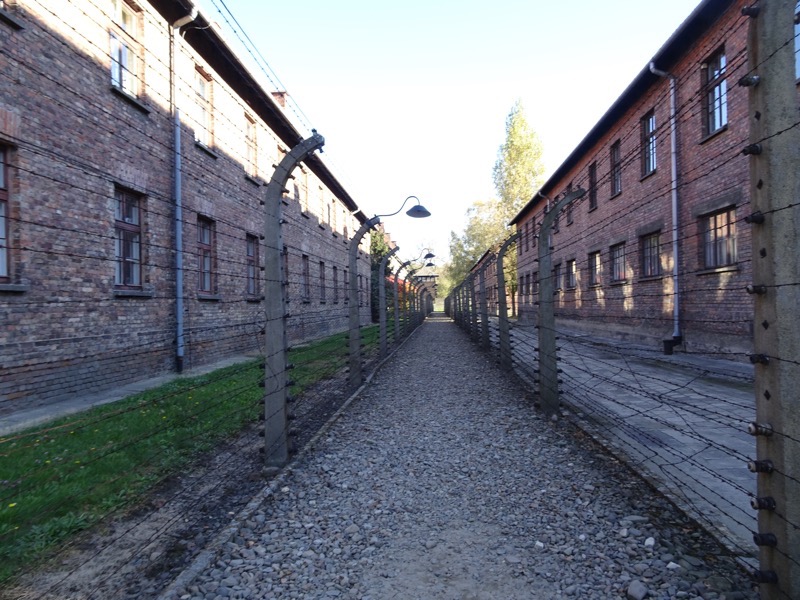
Rudolf Höss was the German SS officer who was the longest-serving Commandant of Auschwitz. He tested and carried into Hitler’s plan to systematically exterminate the Jewish population. Höss lived in a home with his wife and family that is in surprisingly close proximity (about 50m) from the gas chamber and crematorium of Auschwitz KL. It is unbelievable how he could live a regular family life and raise his children so close this horrifying place of daily mass murder.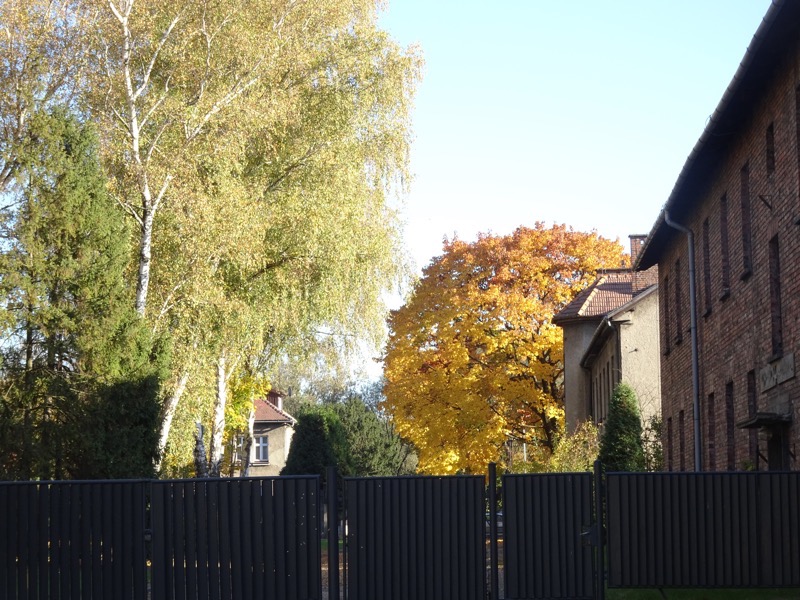 Later, after the war, and after the trials for war crimes, a special gallows was built here and Rudolph Höss was hanged on 16 April 1947, after a trial before the Polish Supreme National Tribunal. Fittingly he was executed at Auschwitz, in between of his former home and the gas chambers. It is not possible to believe that the Höss family didn’t hear, smell and see the airborne ash remains of the prisoners emerging from the chimneys, who met their fate in the gas chambers.
Later, after the war, and after the trials for war crimes, a special gallows was built here and Rudolph Höss was hanged on 16 April 1947, after a trial before the Polish Supreme National Tribunal. Fittingly he was executed at Auschwitz, in between of his former home and the gas chambers. It is not possible to believe that the Höss family didn’t hear, smell and see the airborne ash remains of the prisoners emerging from the chimneys, who met their fate in the gas chambers.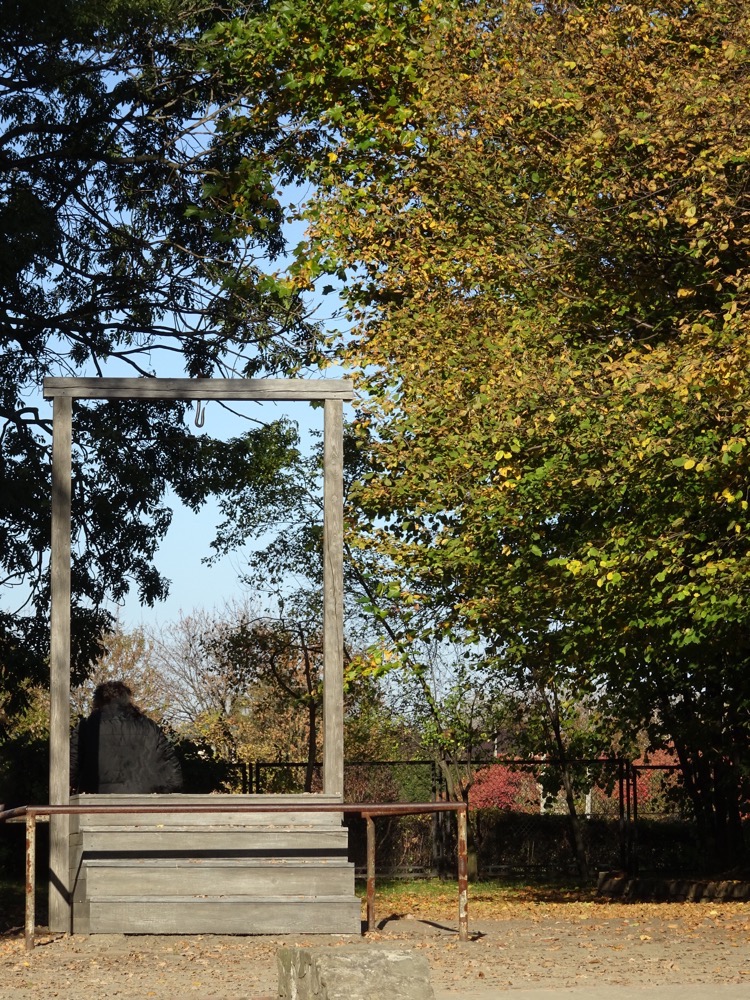
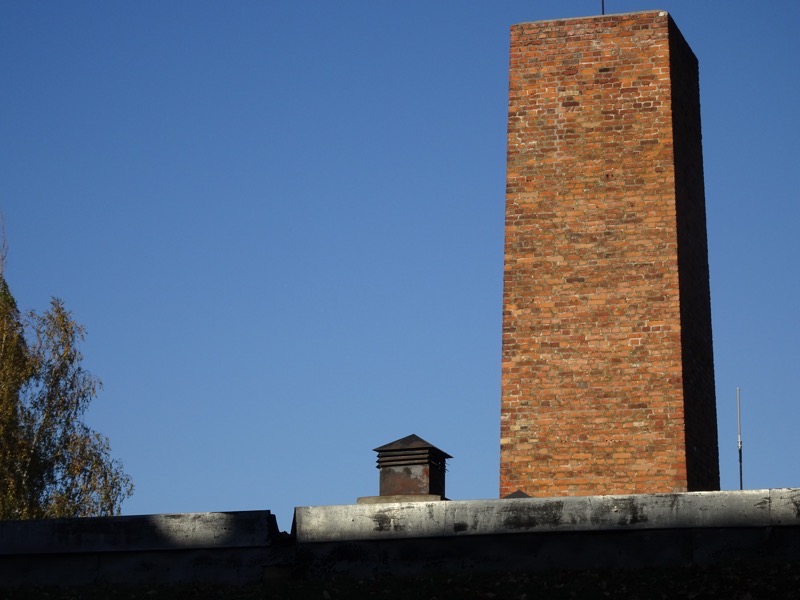
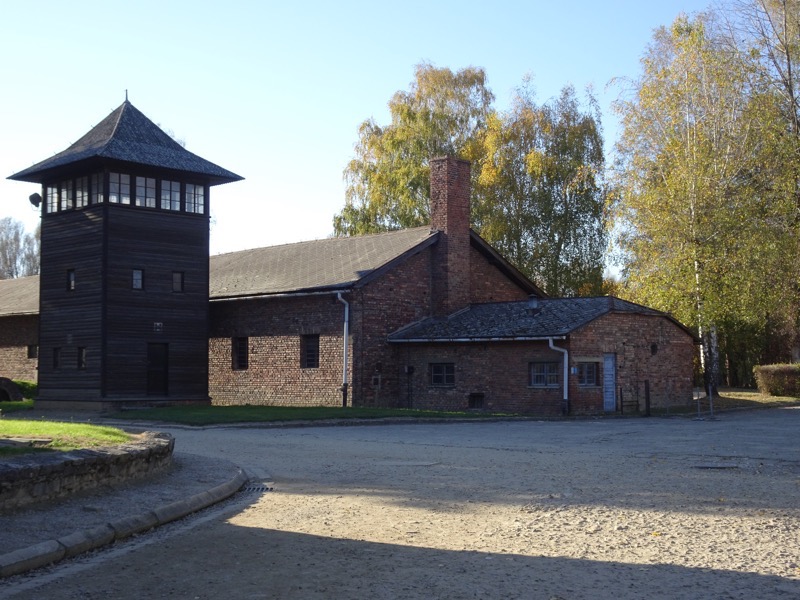 The small gas chamber at KL (Konzentrationslager) Auschwitz:
The small gas chamber at KL (Konzentrationslager) Auschwitz: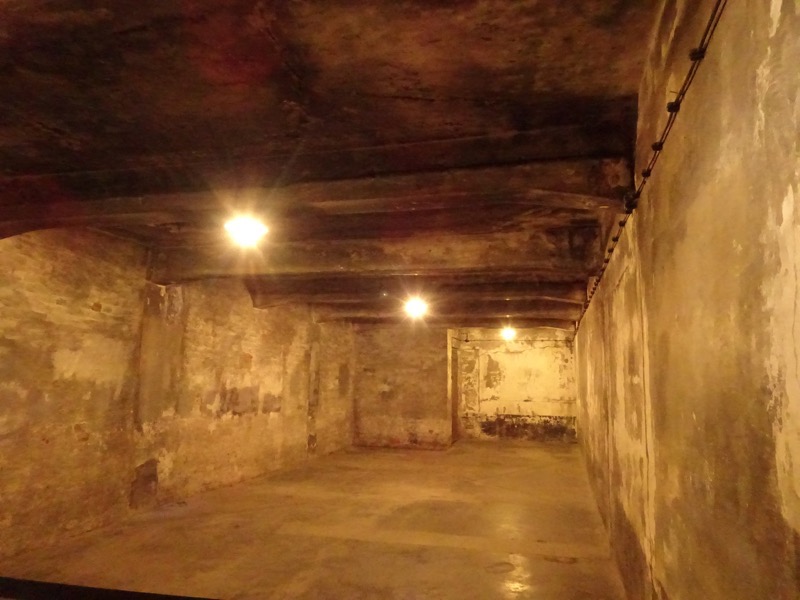
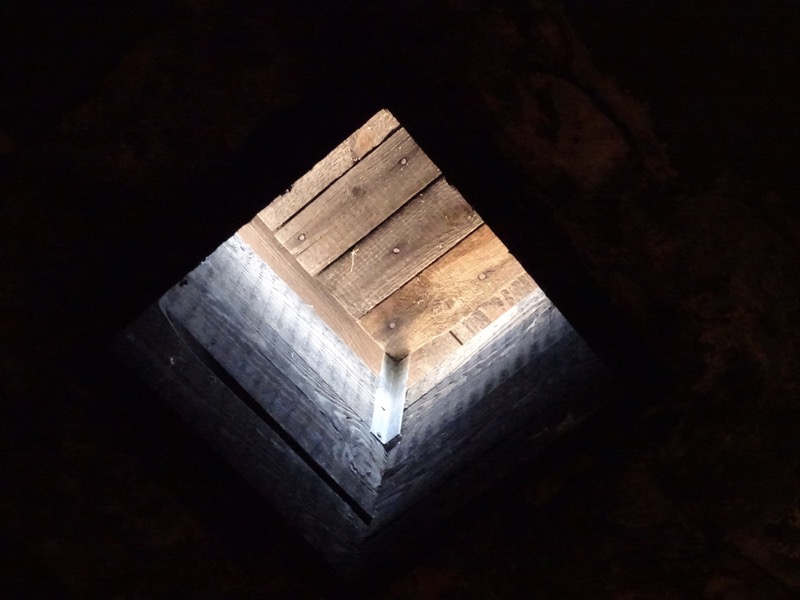 The creamation works directly beside the gas chamber.
The creamation works directly beside the gas chamber.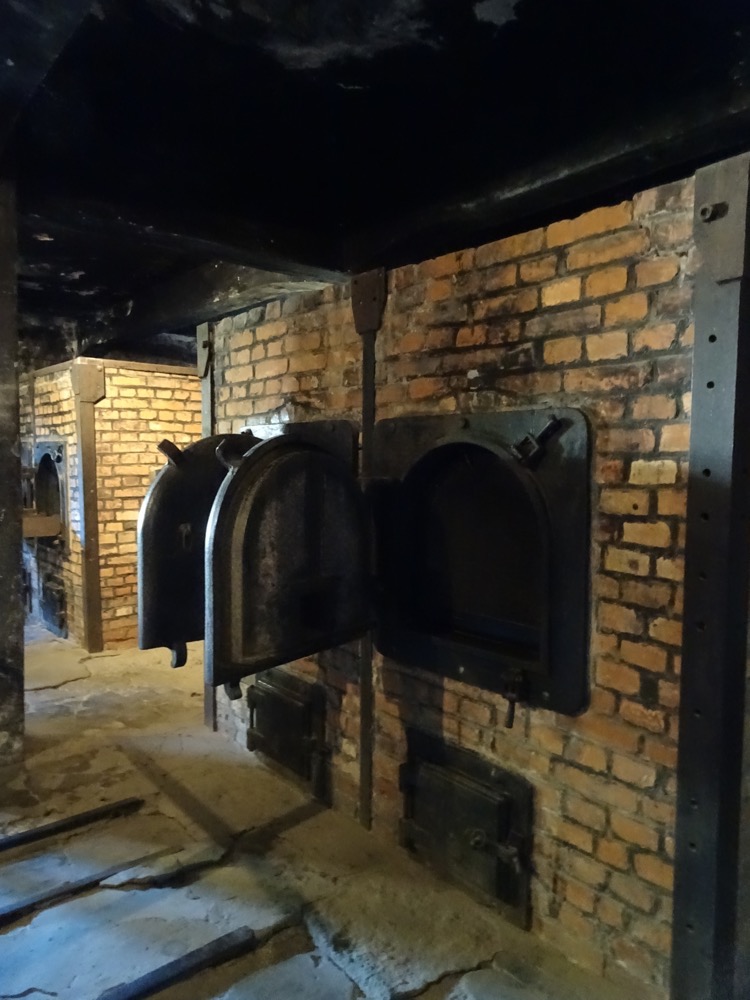
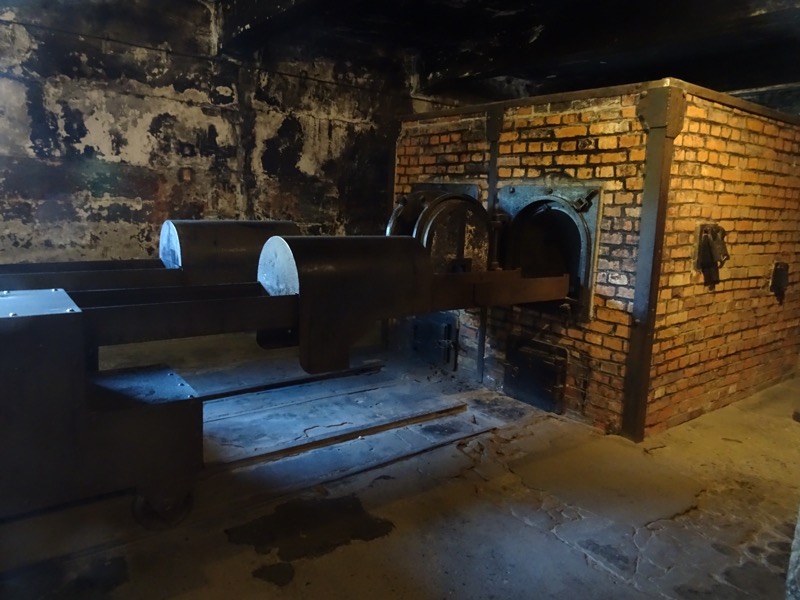 All of which is only divided from the worker/prisoner barracks by two rows of patrolled barbed wire. The prisoners must have also know the fates of those who entered the chambers.
All of which is only divided from the worker/prisoner barracks by two rows of patrolled barbed wire. The prisoners must have also know the fates of those who entered the chambers.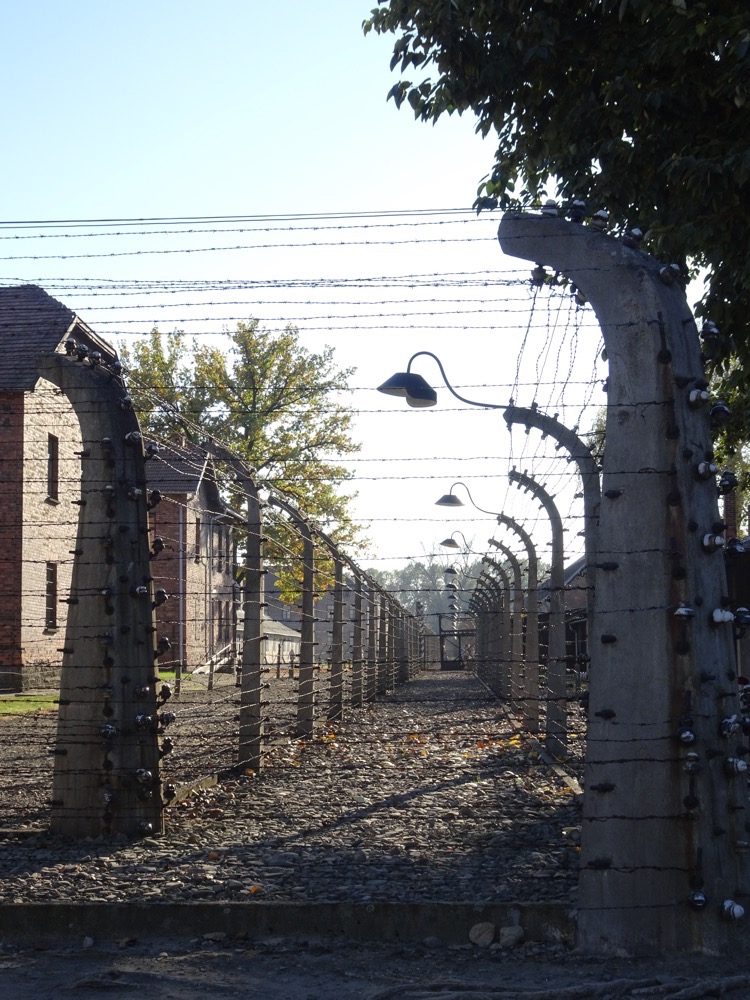
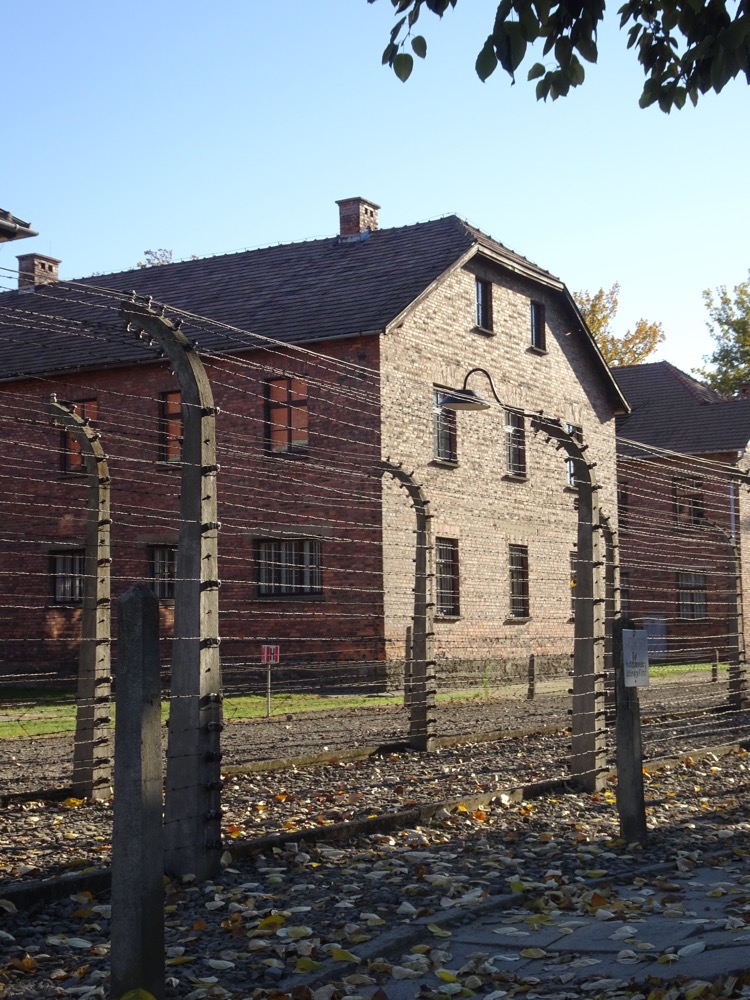 It was at this point we had a break in our tour and I took the opportunity to talk to our guide, Marta, who I had noticed handled the appalling and traumatizing material that she was imparting in a professional, yet very sensitive manner. She was managing to share some truly harrowing content with us in a matter of fact manner, and I wanted to commend her on what I thought must be a difficult and delicate balance between educating visitors and yet now allowing the recitation of bland facts to overwhelm the truly unbelievably vile events that occurred here. I was also curious to know how long she had been guiding visitors through Auschwitz, how many times each day would she go through the complex and how did she manage to not allow the horrific nature of the events that she was constantly discussing not to affect her personally on a psychological level? It turns out that Marta is not actually one of the main tour guides. She is a historian and curator at the museum and she only takes tours on rare occasions.
It was at this point we had a break in our tour and I took the opportunity to talk to our guide, Marta, who I had noticed handled the appalling and traumatizing material that she was imparting in a professional, yet very sensitive manner. She was managing to share some truly harrowing content with us in a matter of fact manner, and I wanted to commend her on what I thought must be a difficult and delicate balance between educating visitors and yet now allowing the recitation of bland facts to overwhelm the truly unbelievably vile events that occurred here. I was also curious to know how long she had been guiding visitors through Auschwitz, how many times each day would she go through the complex and how did she manage to not allow the horrific nature of the events that she was constantly discussing not to affect her personally on a psychological level? It turns out that Marta is not actually one of the main tour guides. She is a historian and curator at the museum and she only takes tours on rare occasions.
yale looked Marta up online later to find out more about her background and we discovered she is one of the preeminent specialists in educational projects connected to the Auschwitz memorials and museums.
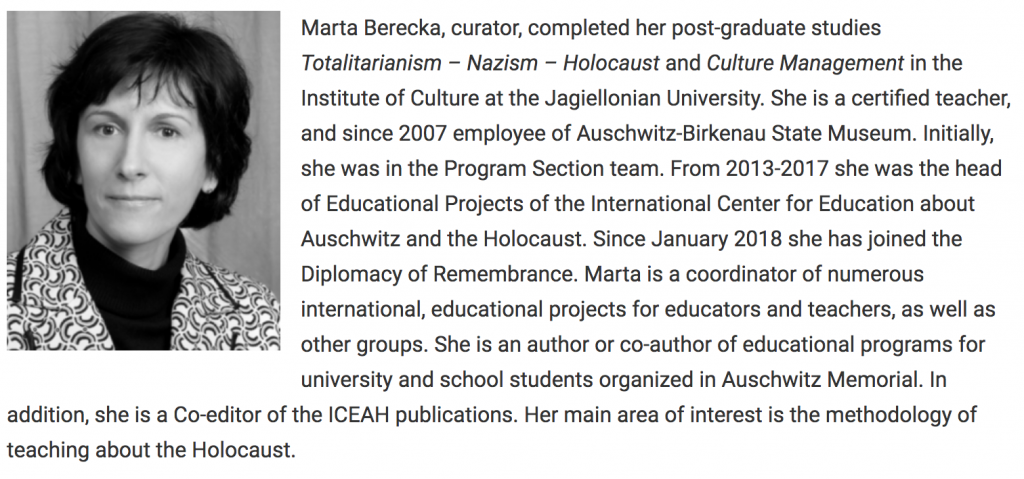
After reading her biography I can see now why she was so willing to engage in a discussion with me, regarding the important role she feels the museum plays in educating generations of people who are now less directly connected to the atrocities committed here. She said that 15 years ago, many of their visitors all knew someone or had met someone who was directly connected to the concentration camps… now the living memories of what happened here during the Holocaust were starting to fade, as the survivors themselves were passing away. It was obvious that Marta was very connected to the material having visited Auschwitz many times. Before she started working for the museum she worked with survivors and participated in helping to collect testimonies of peoples’ experiences at Auschwitz. While Marta somehow managed to maintain the professionalism of an academic, it was obvious that her empathy for these people and this place was genuine but also somehow composed, calm and tempered. I am not sure I could do this work – though I do believe her role in educating future generations on the atrocities committed at Auschwitz is vitally important… in the current political climate, perhaps now more than ever.
Our tour continued after a short bus ride to the larger camp area of Auschwitz II-Birkenau. Whereupon we were greeted by rows and rows of brick or timber barracks as far as the eye could see. I had no idea the sheer scale of this camp. I guess you read that it is 180ha and accommodated up to 130,000 prisoners, but the size of this place and the human misery that it must have seen is on a scale that I found difficult to comprehend. We approached by the famous brick rail gate and started walking into the camp. To our right were the timber barracks belonging to the male prisoners, in sections B1, B2, B3, B4, B5 all the way back to ‘Kanada’.
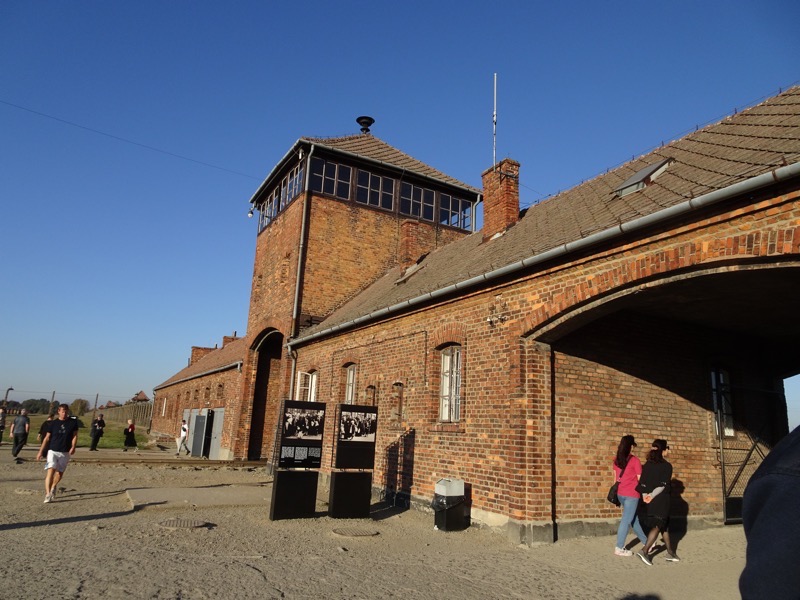
‘Kanada’ was a series of warehouses where the belongings of the murdered prisoners were taken to be sorted and redistributed to the Reich. Many of the goods acquired here were the portable items of value that the deported Jews were able to bring with them when they were hastily removed from their homes and then removed again from the ghettos. Jobs in Kanada were highly prized and often given to the ‘favourite’ prisoners of powerful SS officers. Having friends in Kanada could mean access to warmer clothing, and possible food to supplement rations or goods to barter with.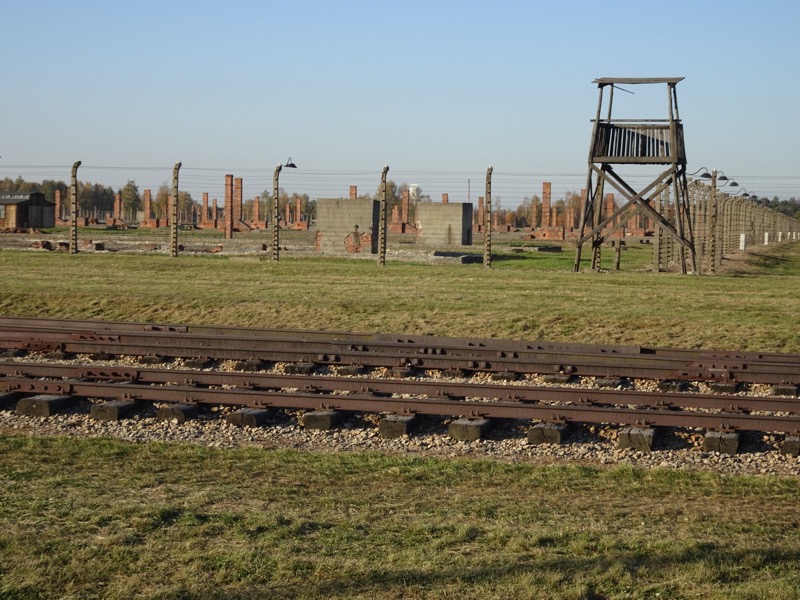

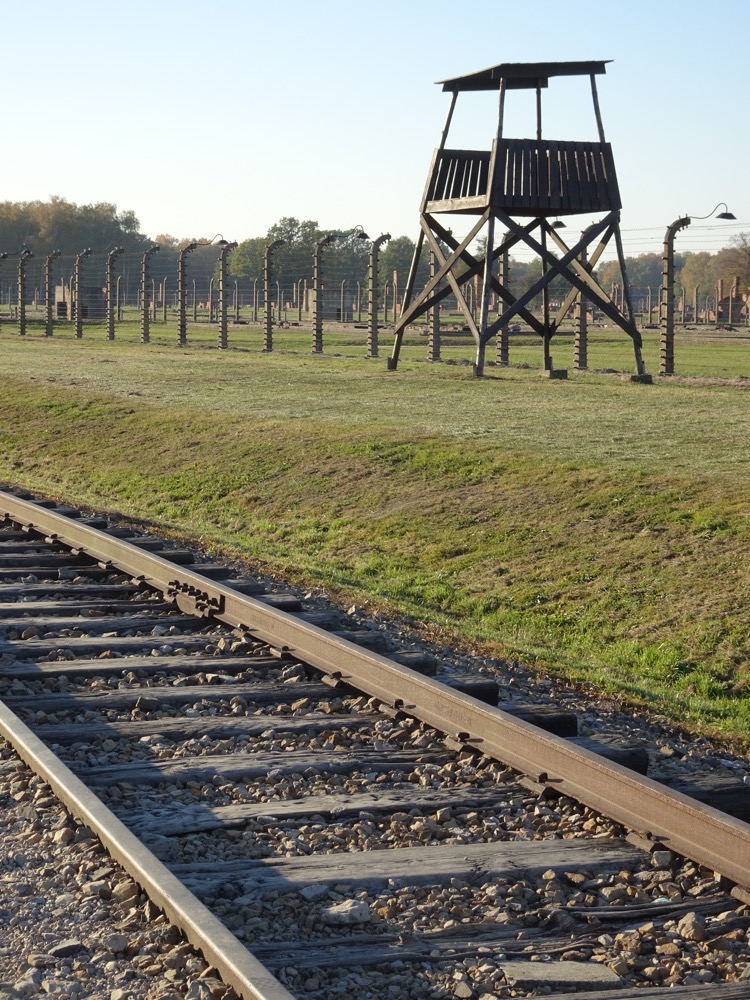 It was during this part of the tour that the sheer scale of the camp hits visitors hard. One hundred and eighty hectares of organised misery, degradation and for most, eventual death.
It was during this part of the tour that the sheer scale of the camp hits visitors hard. One hundred and eighty hectares of organised misery, degradation and for most, eventual death.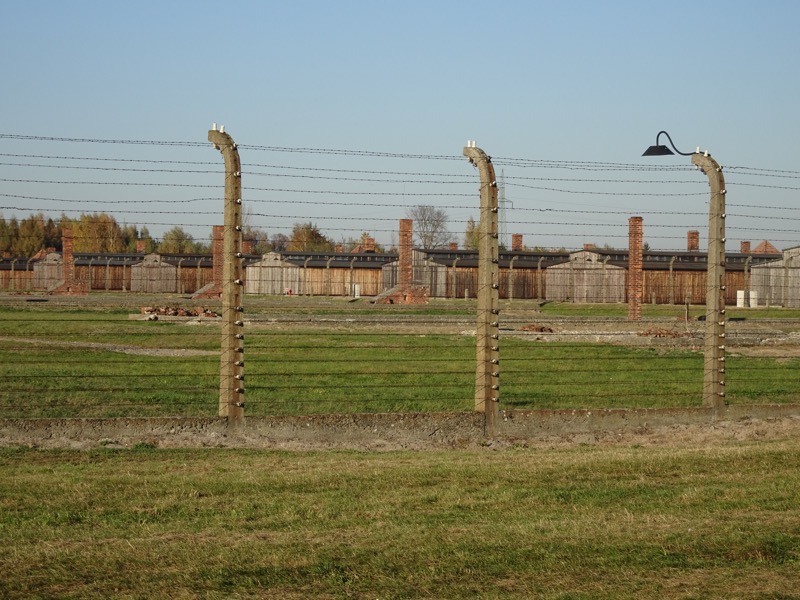 A replica of the railway cars which were used to transport most of the deportees to Auschwitz-Birkenau. Eighty to one hundred people were crammed into these cars for journeys lasting days with no food, no water and no toileting facilities. Tens of thousands of people arrived at the camp in cars just like this one.
A replica of the railway cars which were used to transport most of the deportees to Auschwitz-Birkenau. Eighty to one hundred people were crammed into these cars for journeys lasting days with no food, no water and no toileting facilities. Tens of thousands of people arrived at the camp in cars just like this one.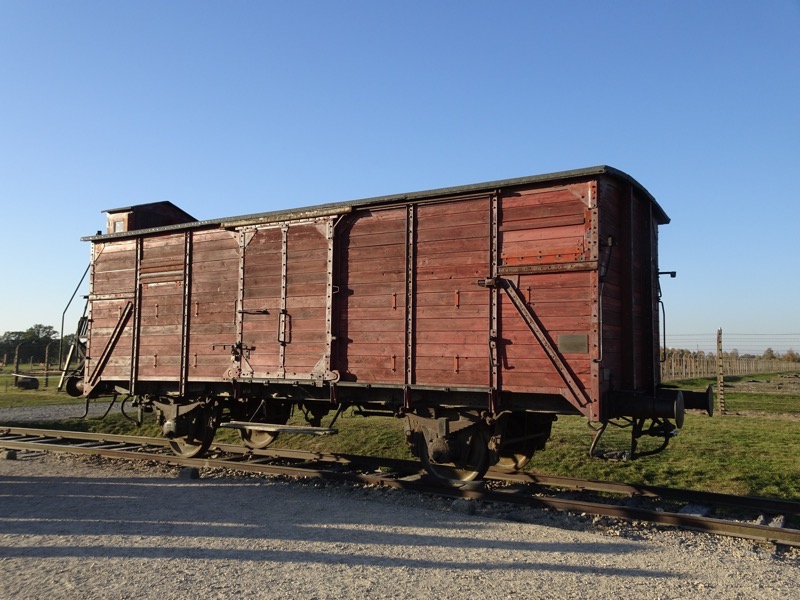 The further into the camp we walked, the size of the camp became more and more apparent.
The further into the camp we walked, the size of the camp became more and more apparent.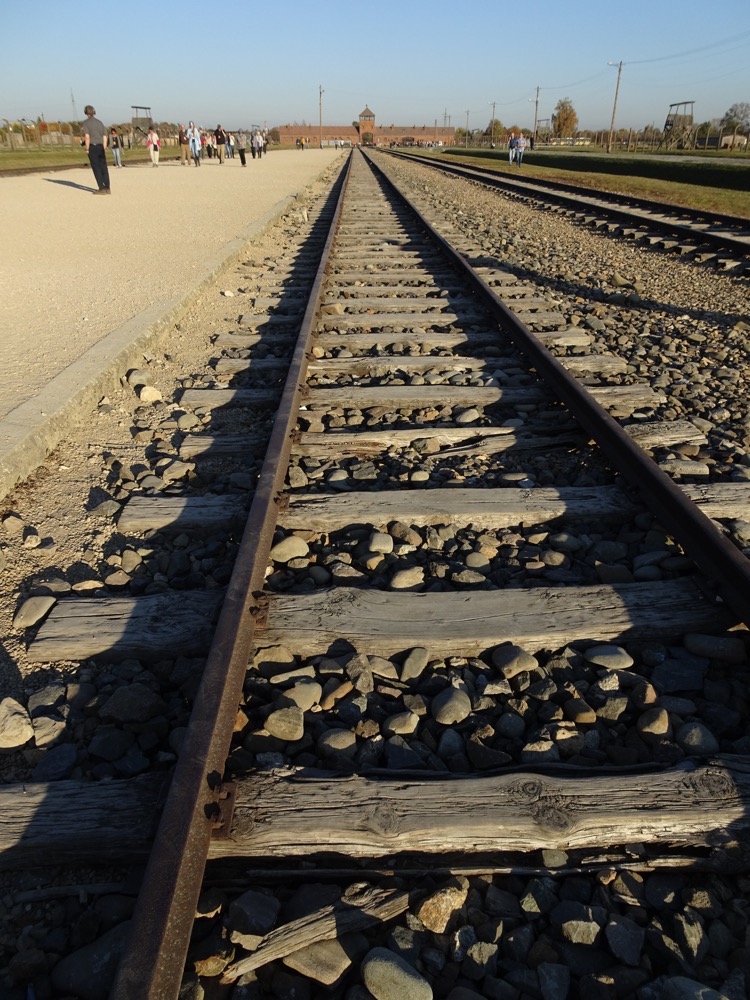
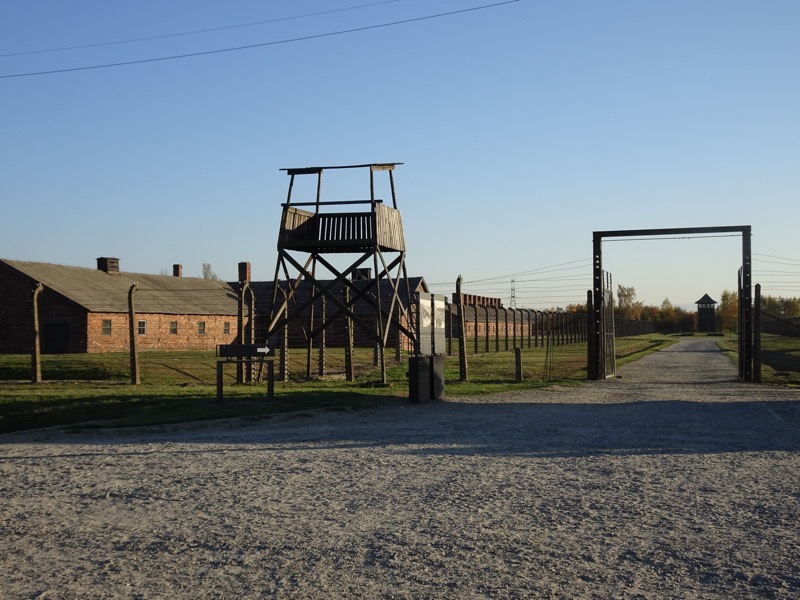
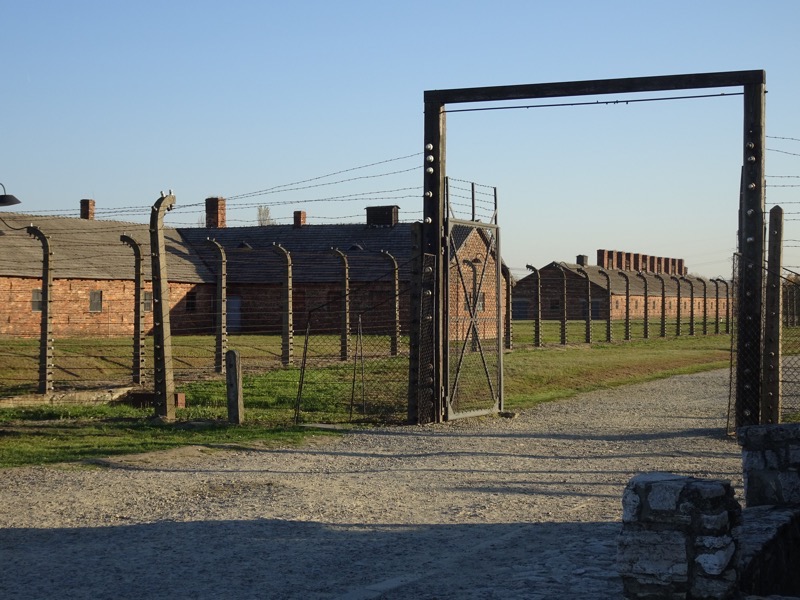 At the ramps at the end of the train tracks where the selection processes were carried out. Behind us is the massive L shaped gas chamber and industrial creamatoria complex.
At the ramps at the end of the train tracks where the selection processes were carried out. Behind us is the massive L shaped gas chamber and industrial creamatoria complex.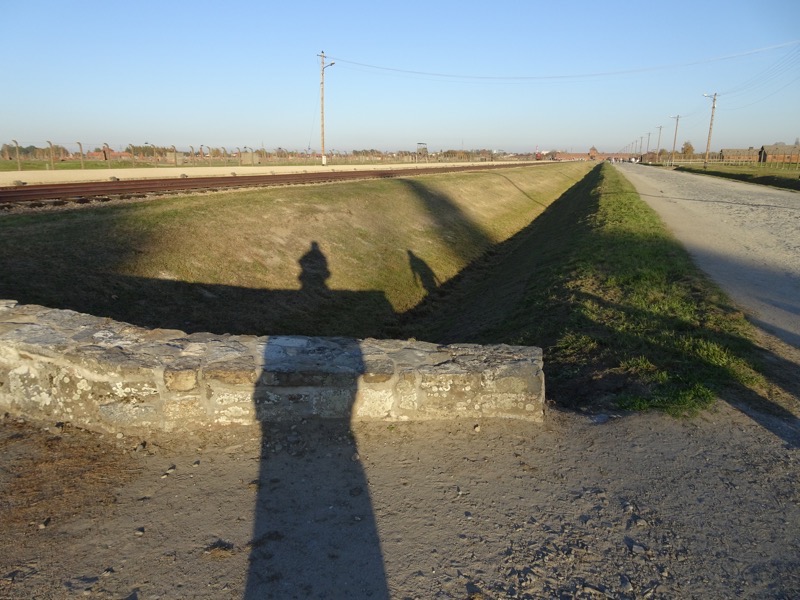 The underground undressing chamber. Destroyed by departing Nazis as the end of the war became a certainty.
The underground undressing chamber. Destroyed by departing Nazis as the end of the war became a certainty.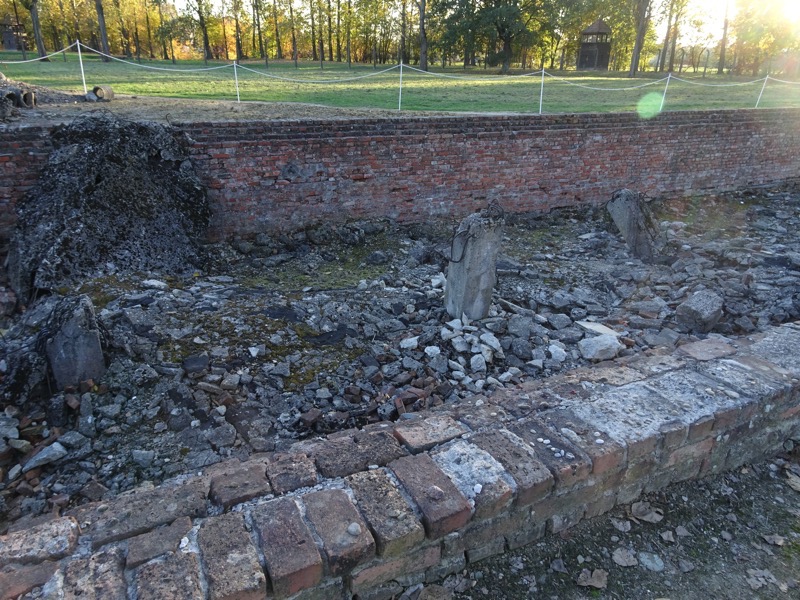 The collapsed roof of the gas chambers:
The collapsed roof of the gas chambers: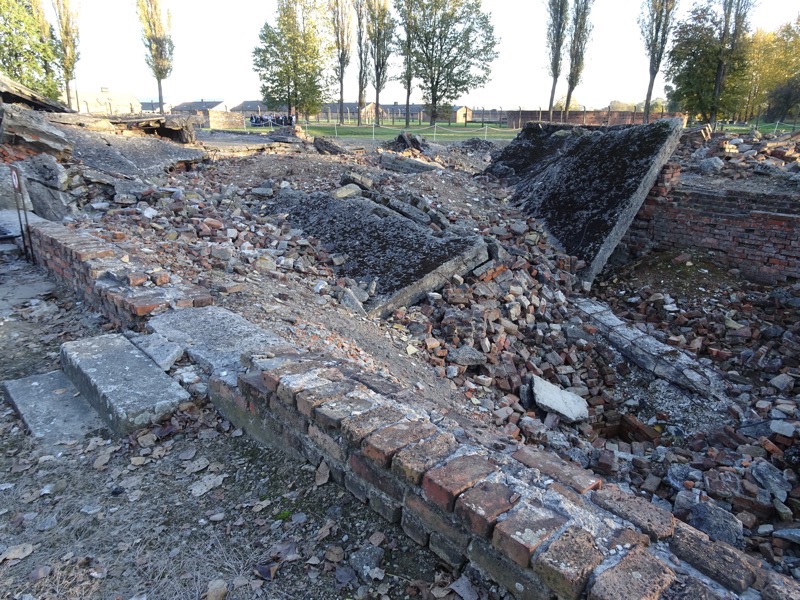
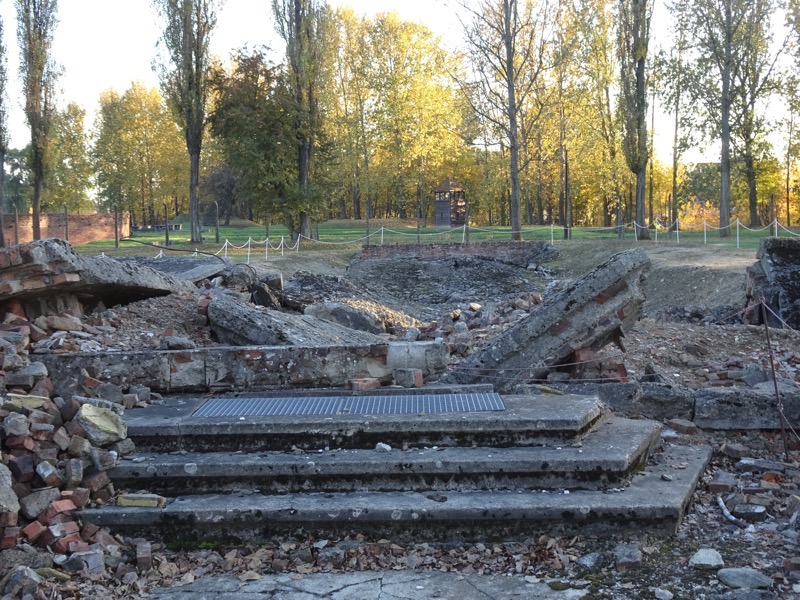 The ruins of the cremation ovens:
The ruins of the cremation ovens: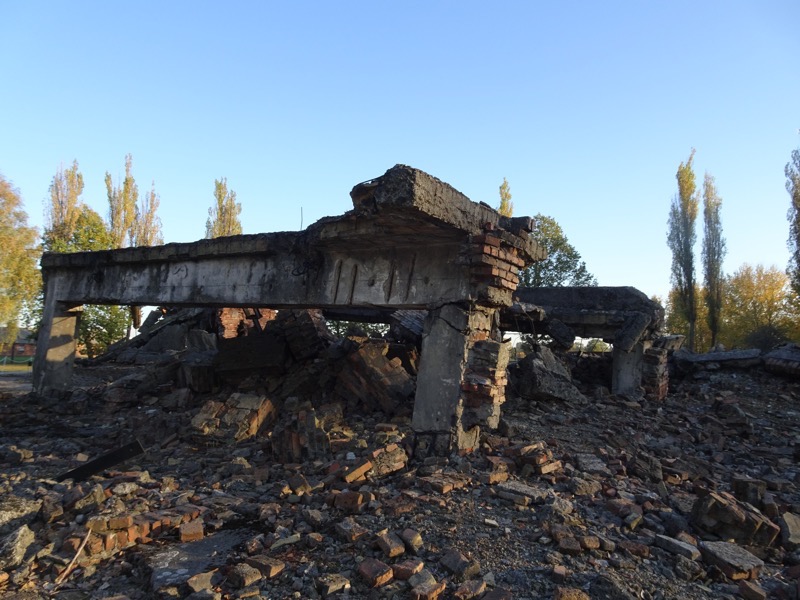 Much of the terrible work carried out in the mass extermination of the Jewish population was Sonderkommandos. The Sonderkommandos were a work detail made up of prisoners from the death camp. They were not civilian workers but were prisoners – usually Jewish – who were forced to work and aid in the management of victims, the looting of the bodies, and the disposal of the corpses in the gas chambers during the Holocaust. They were forced to complete this gruesome work or be killed themselves.
Much of the terrible work carried out in the mass extermination of the Jewish population was Sonderkommandos. The Sonderkommandos were a work detail made up of prisoners from the death camp. They were not civilian workers but were prisoners – usually Jewish – who were forced to work and aid in the management of victims, the looting of the bodies, and the disposal of the corpses in the gas chambers during the Holocaust. They were forced to complete this gruesome work or be killed themselves. 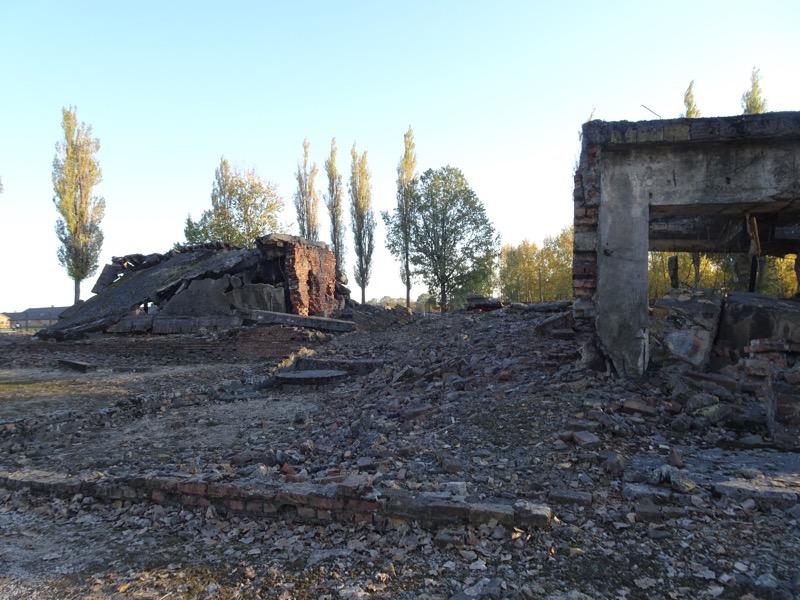
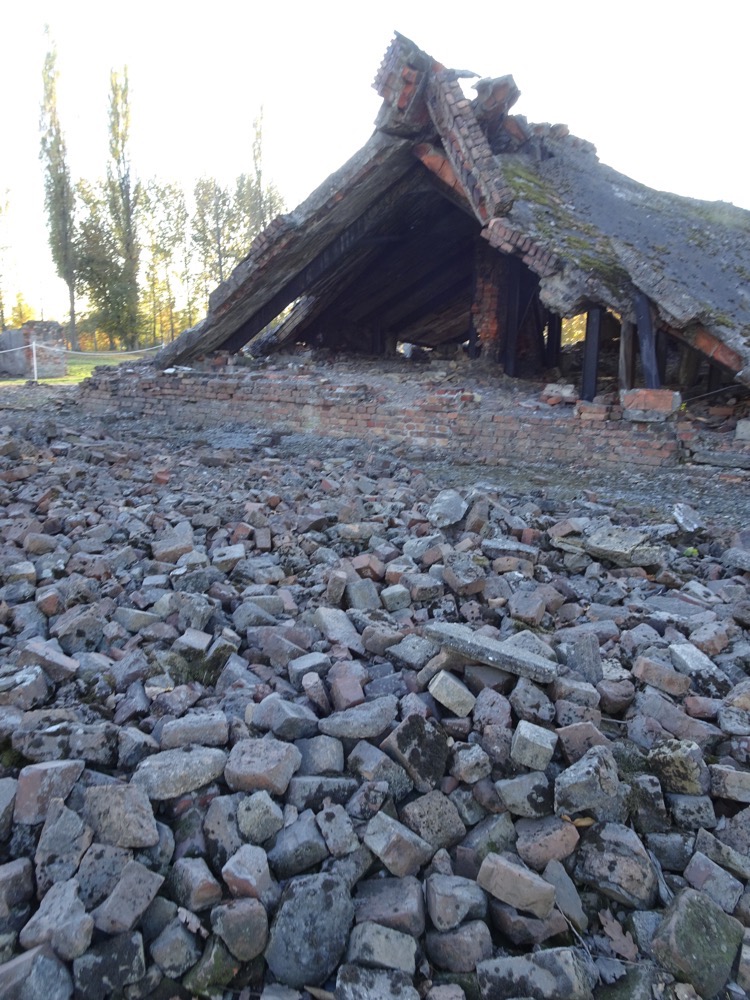
Red brick barracks made from building materials repurposed from the villages that were destroyed to make way for the camp: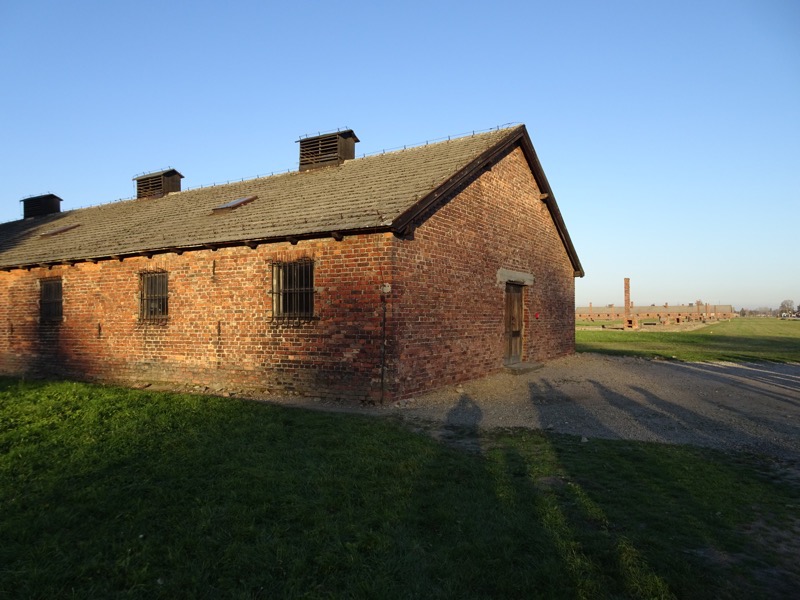
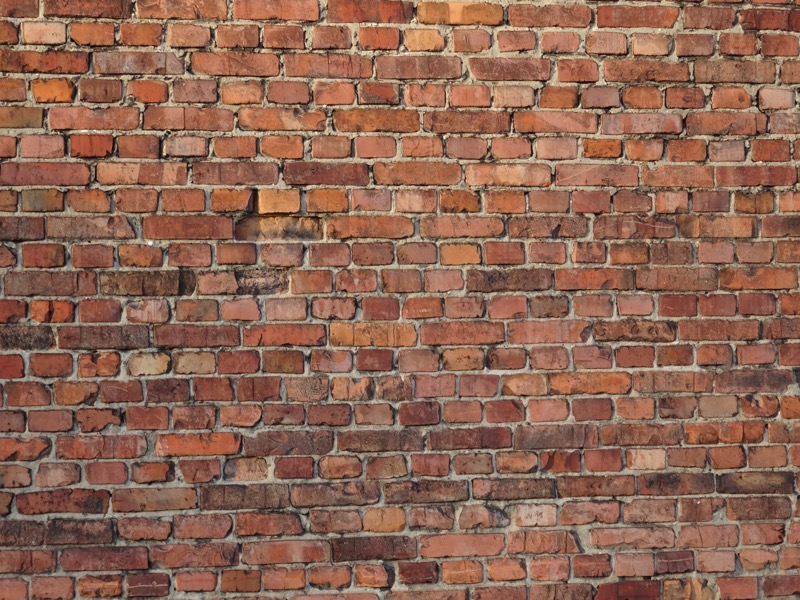
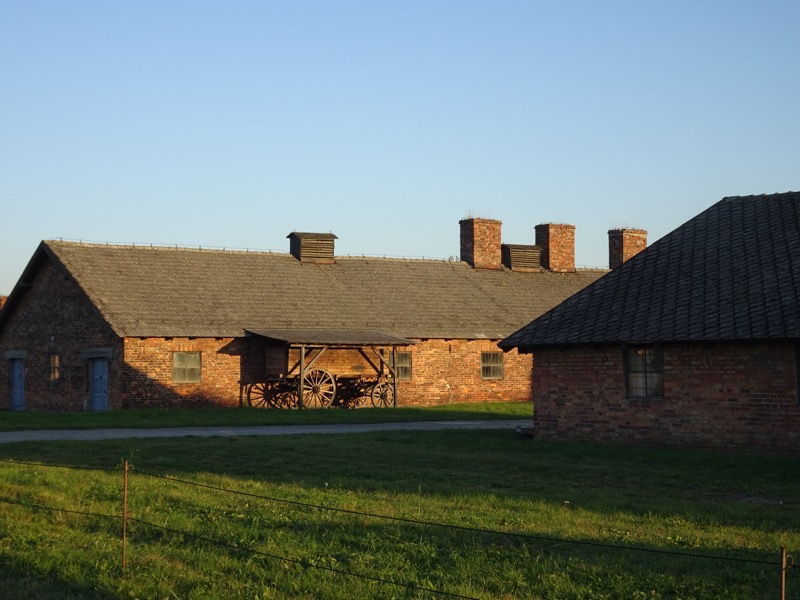
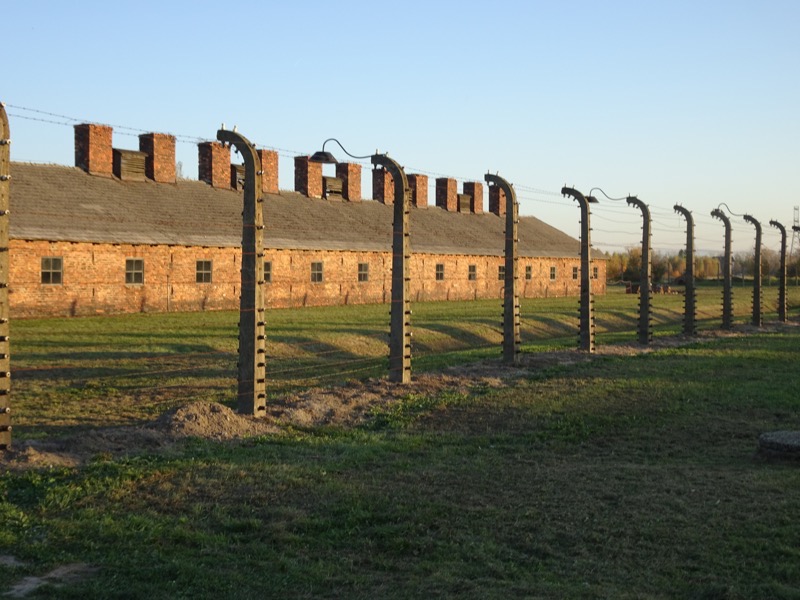 Inside Barracks 16A. ‘Beds’, such as they were, were three stories high and housed four to five people in each space. Necessary for warmth in winter but swelteringly uncomfortable and unsanitary in summer.
Inside Barracks 16A. ‘Beds’, such as they were, were three stories high and housed four to five people in each space. Necessary for warmth in winter but swelteringly uncomfortable and unsanitary in summer.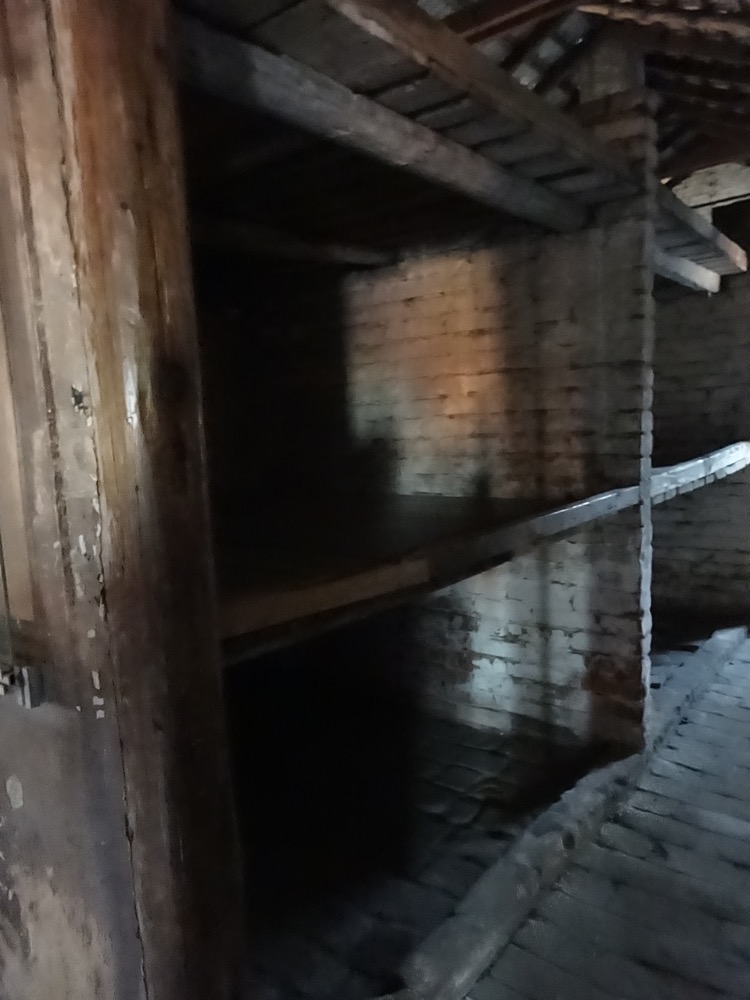 There were no washing facilities in the buildings. Any bathing had to occur outside.
There were no washing facilities in the buildings. Any bathing had to occur outside.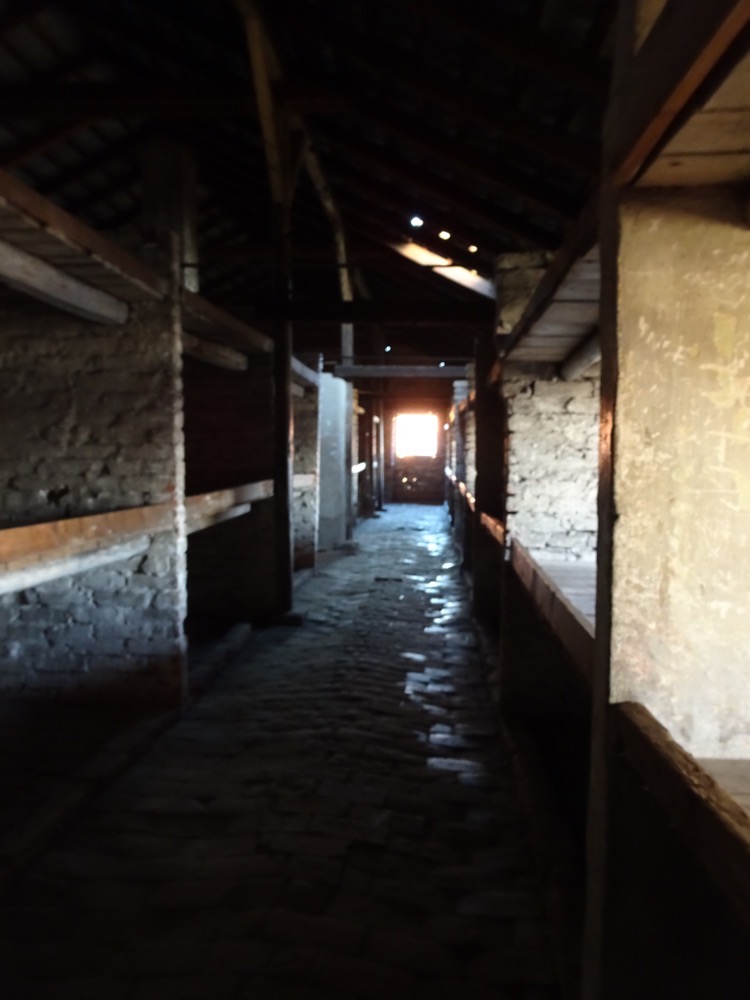
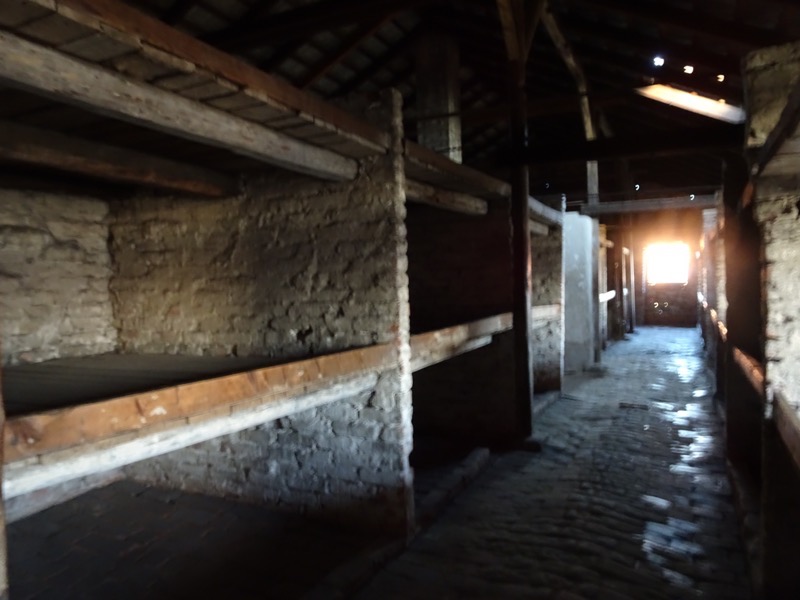
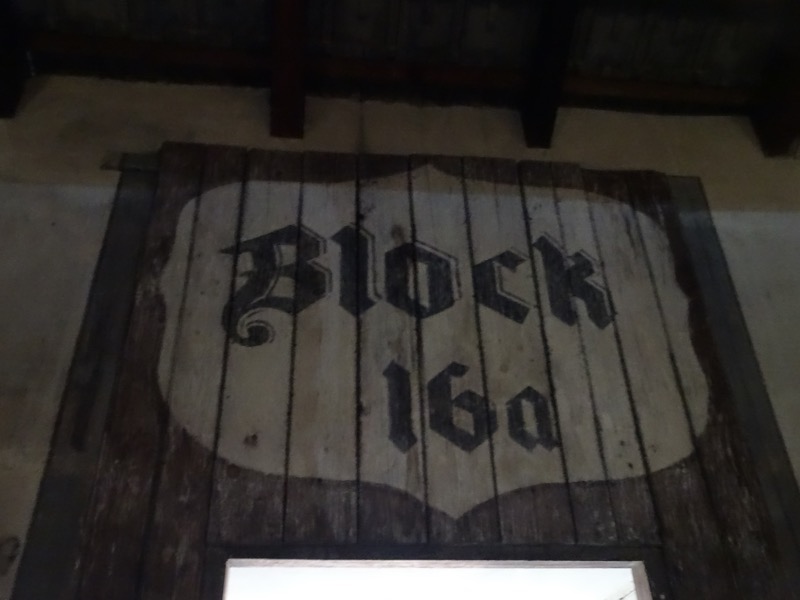 There is much more that could be said about Auschwitz-Birkenau, and there are incalculable books on the topic that adequately demonstrate that. But there is little that captures the feeling of being here and physically taking in this history in person.
There is much more that could be said about Auschwitz-Birkenau, and there are incalculable books on the topic that adequately demonstrate that. But there is little that captures the feeling of being here and physically taking in this history in person.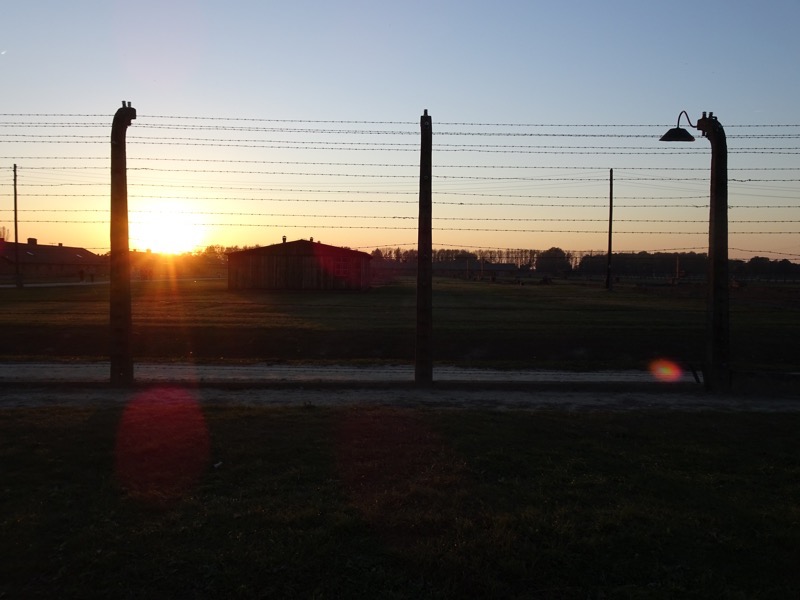
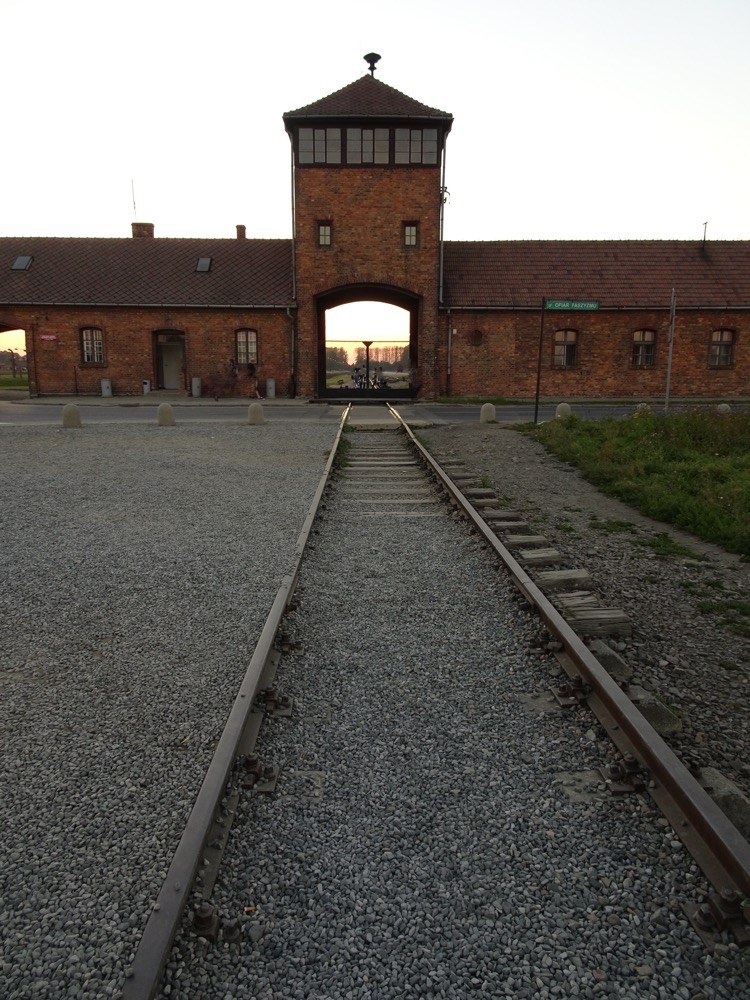 As I was saying to Marta, I don’t remember a time in my life where I learned about the atrocities committed by the Nazis during WWI. I don’t remember gleaning this knowledge for the first time and being shocked and appalled by the inhumanity of it. I grew up seemingly always aware of Hitler, of Nazism, of the concentration camps almost by osmosis. The knowledge I always had merely grown in depth and detail as I got older… but having said this, I feel much like I didn’t really understand the extent of the horrors committed here until today. The scale of the brutality is unimaginable until you are faced with it.
As I was saying to Marta, I don’t remember a time in my life where I learned about the atrocities committed by the Nazis during WWI. I don’t remember gleaning this knowledge for the first time and being shocked and appalled by the inhumanity of it. I grew up seemingly always aware of Hitler, of Nazism, of the concentration camps almost by osmosis. The knowledge I always had merely grown in depth and detail as I got older… but having said this, I feel much like I didn’t really understand the extent of the horrors committed here until today. The scale of the brutality is unimaginable until you are faced with it.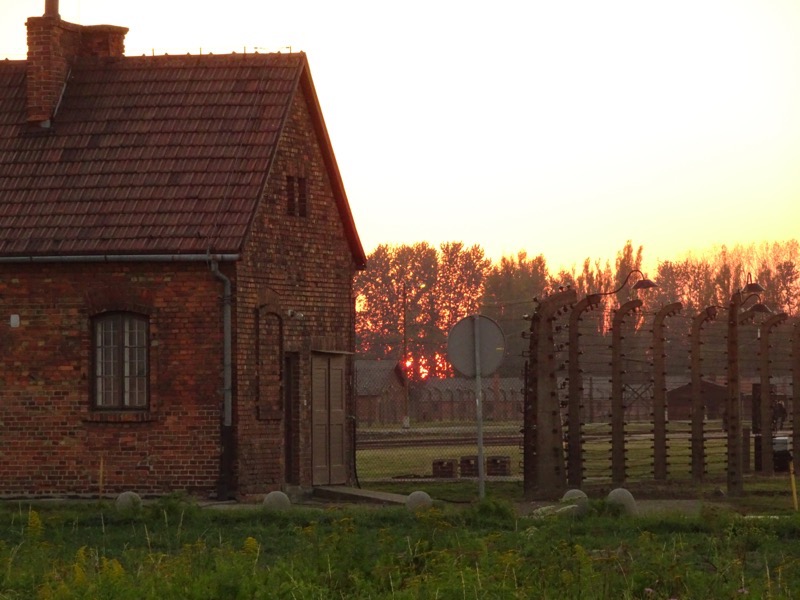 “The last thing to die is hope…”
“The last thing to die is hope…”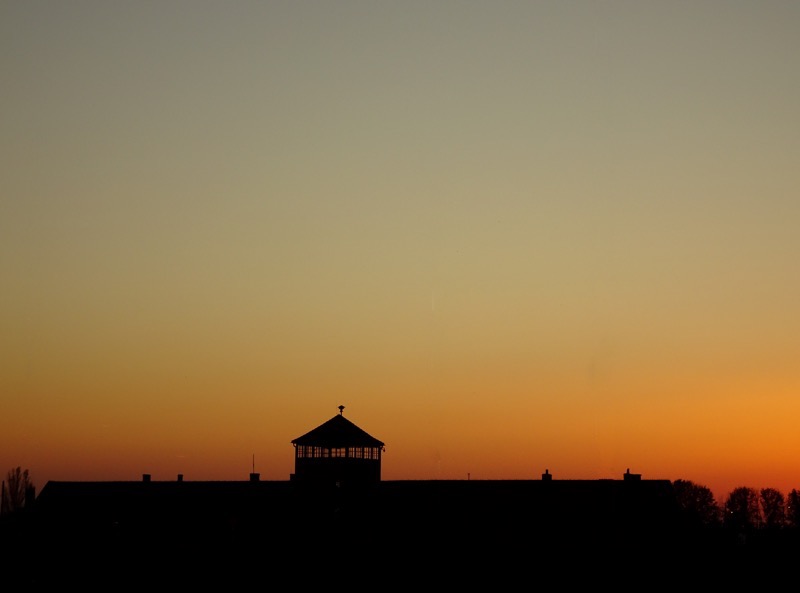
I have had to put this post aside several times as writing this all down and compiling these images have been exhausting. After we drove back to Krakow, we went hunting for something a bit more uplifting to finish the day. We found it in the form of a quaint and quirky little restaurant in the Jewish Quarter called, “Once Upon a Time in Kazimierz”. There was live music and great local food on the menu – exactly what we could have hoped for.
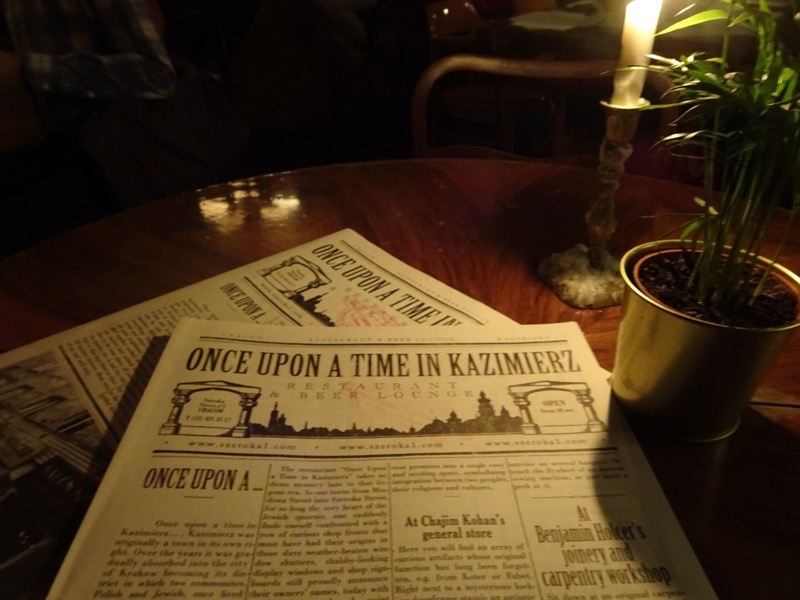 Weird and wonderful decor – one couple found themselves seated at a table that was actually an old treadle sewing machine.
Weird and wonderful decor – one couple found themselves seated at a table that was actually an old treadle sewing machine. Jewish Caviar – chopped chicken livers with eggs in truffle aroma, served with rye bread and whipped butter.
Jewish Caviar – chopped chicken livers with eggs in truffle aroma, served with rye bread and whipped butter. Beef and thyme pierogi, half and half (friend and boiled).
Beef and thyme pierogi, half and half (friend and boiled). Fillet of trout with vegetables in orange butter sauce (zucchini, leek and carrot).
Fillet of trout with vegetables in orange butter sauce (zucchini, leek and carrot). Jerusalem mix – chicken breast, liver, hearts in oriental spices and onion. Delicious!
Jerusalem mix – chicken breast, liver, hearts in oriental spices and onion. Delicious! We were the last to leave the restaurant after a couple more ciders!
We were the last to leave the restaurant after a couple more ciders!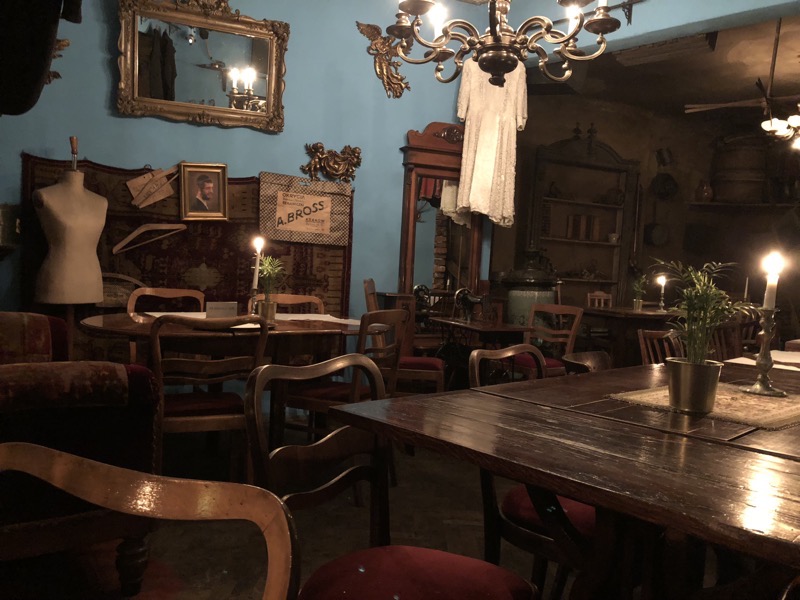 Dessert for yale: Pecan pie with vanilla ice cream:
Dessert for yale: Pecan pie with vanilla ice cream: And for me – steaming mead.
And for me – steaming mead.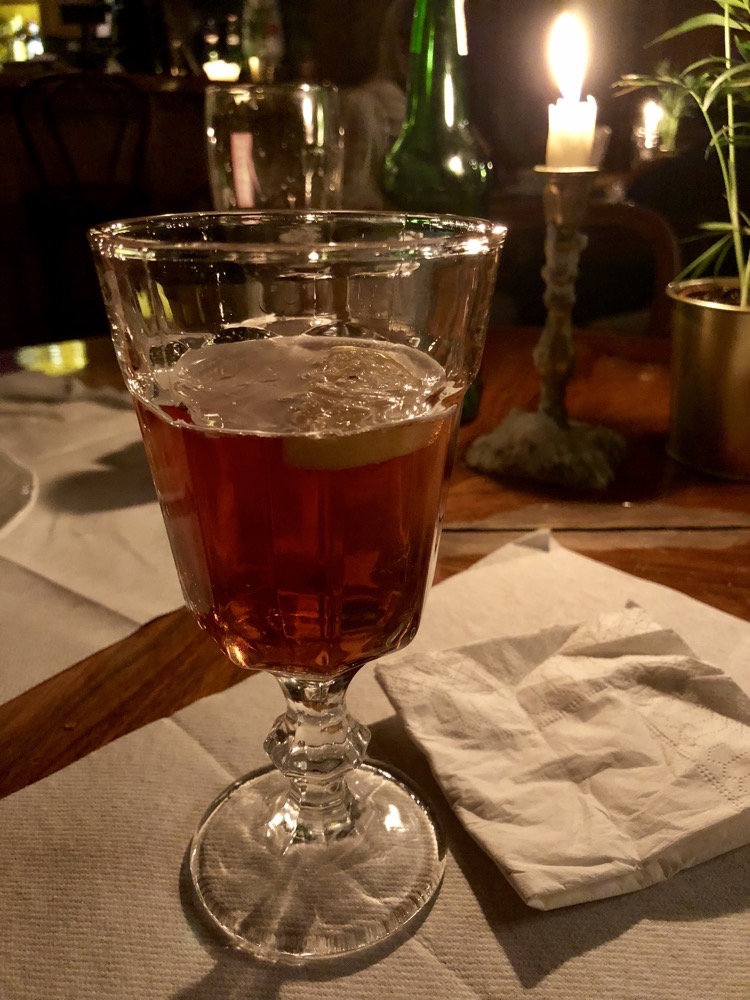 Long day. Need good sleep. Thankfully my, “can I speak to the manager” chat with the night conceirge guy has yielded a different room in the hotel with a better bed. Fingers crossed!
Long day. Need good sleep. Thankfully my, “can I speak to the manager” chat with the night conceirge guy has yielded a different room in the hotel with a better bed. Fingers crossed!

